[Die Combinations of] Unrelated Obverses and Reverses of Ancient Coins in Jacopo Strada’s Numismatic Works
Zusammenfassung:
In dem Beitrag werden einige dieser
Stempelkombinationen vorgestellt und es wird der Frage
nachgegangen, was Strada zu diesen Zusammenstellungen veranlasst
haben könnte. Hat er diese Münzen wirklich gesehen, d. h.
existierten sie zu seiner Zeit und sind nicht auf uns gekommen
oder hat er sie komplett ›erfunden‹?
Dazu sollen auch die Werke seiner Zeitgenossen herangezogen
werden (Pirro Ligorio, Sebastiano Erizzo, Antonio Agustín), um
zu überprüfen, ob sich diese möglicherweise erfundenen
Stempelkombinationen auch in deren Werken wiederfinden. Dadurch
ergeben sich neue Einblicke in die Arbeits- und Vorgehensweise
renaissancezeitlicher Antiquare.
Schlagwörter: Jacopo Strada
http://d-nb.info/gnd/118834320, Geschichte der Numismatik,
Münzaverse und -reverse, Stempelkombinationen, Antiquare der
Renaissance,
Pirro Ligorio
http://d-nb.info/gnd/118779966, Enea Vico
http://d-nb.info/gnd/119099950, Antonio Agustín, Hubertus
Goltzius
http://d-nb.info/gnd/138826153, Sebastiano Erizzo
http://d-nb.info/gnd/139904328
Abstract:
In his surviving numismatic manuscripts (i.e.
Magnum ac Novum Opus, Diaskeué, Series
Imperatorum Romanorum) Jacopo Strada describes coin obverses
and reverses as belonging together, when in reality they had
originally been part of coins displaying other obverses and
reverses. In some volumes of the MaNO and Diaskeué,
the occurence of such coins is very high (e.g. coins of
Augustus, Antoninus Pius, Marcus Aurelius). By naming their
sixteenth-century owners in the Diaskeué, Strada gave
them a supposedly secure authenticity.
My contribution presents
some of these ›combinations‹ and examines what may have prompted
Strada to create them. Did he really see these coins, i.e. did
they exist in his time but have not been preserved, or did he
completely ›invent‹ them? This investigation will also involve
the works of his contemporaries (Pirro Ligorio, Sebastiano
Erizzo, Antonio Agustín) to check whether such potentially
invented ›combinations‹ can also be found in the works of other
antiquarians. This investigation will also provide new insights
into the work and approach of renaissance antiquarians.
Key words:
Jacopo Strada, history of numismatics, coin obverses and
reverses, die combinations, renaissance antiquarians, Pirro
Ligorio, Enea Vico, Antonio Agustín, Hubertus Goltzius,
Sebastiano Erizzo
Jacopo Strada (b.
1505‒1515, d. 1588), an antiquarian from Mantua, was the author
of a considerable number of manuscripts and books dealing with
Greek coins, coins of the Roman Republic and the Roman emperors
to the mid-sixteenth century[1].
According to his own statement, the Diaskeué should
provide the complementary coin descriptions to his corpus of
drawings of coins of the Roman emperors[2].
I.
In the Diaskeué
(fig. 1a), the eleven-volume work with
descriptions of coins from antiquity to his own time, Strada
presented coin obverses and reverses as if they belong together,
when in reality they had actually been combined with other
obverses and reverses[3].
Illustrations of these fictitious combinations can also be found
in the MaNO (fig. 1b), a corpus of
coin drawings from antiquity to the days of Charles V, which
includes over 8,500 examples[4].
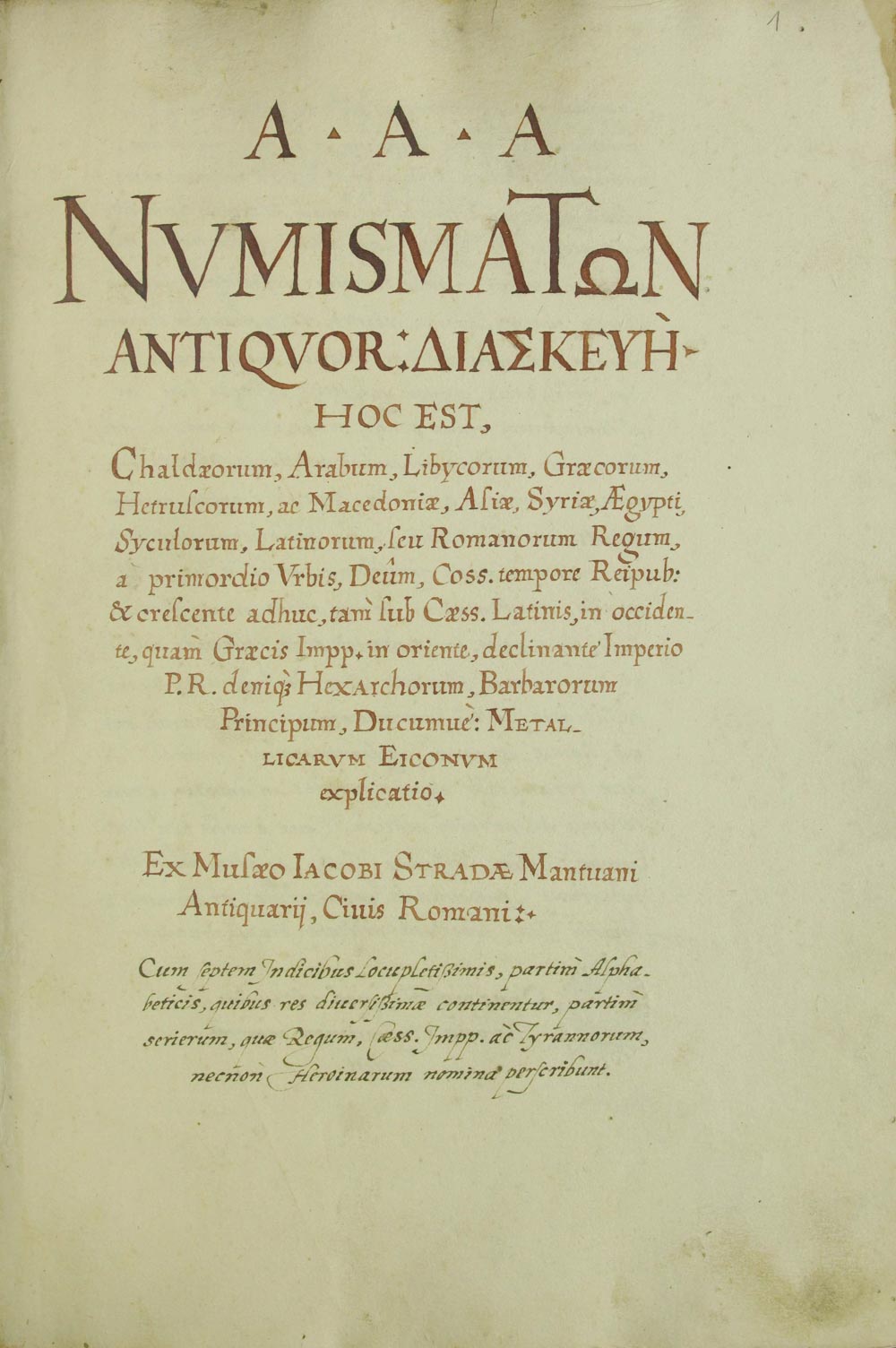
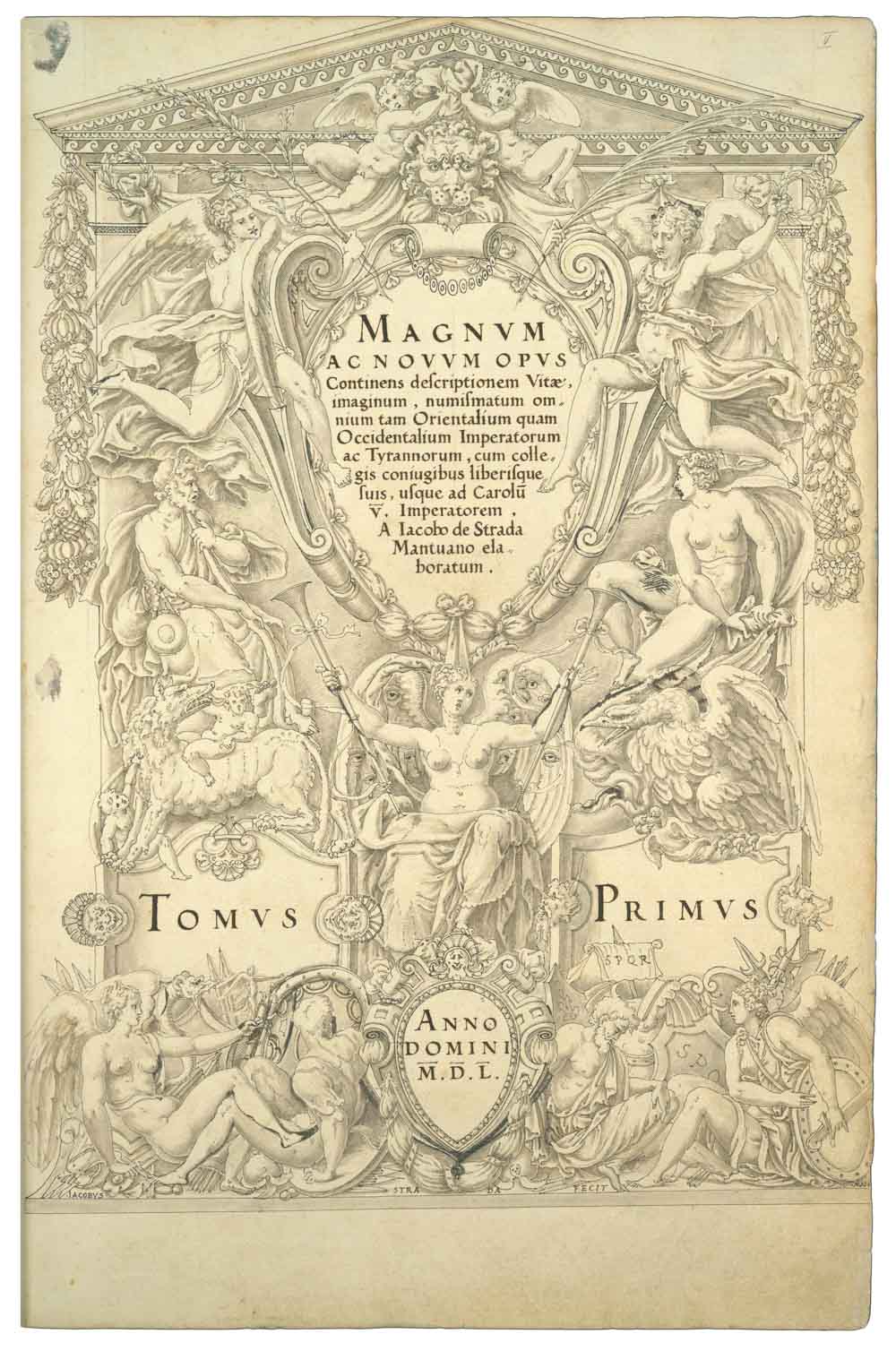
I limited the selection
to the coins of Augustus, since in this case the comparative
material was the largest: Coins illustrated in the works of Enea
Vico, Antonio Agustín, Sebastiano Erizzo, Hubertus Goltzius and
Pirro Ligorio may be compared. Moreover, in his Discorsi
of 1592, Antonio Agustin listed the above-mentioned
antiquarians, as well as Strada. These scholars and collectors
seem to have formed some kind of numismatic circle and exchanged
information and coin drawings among them[5].
The work of Sebastiano Erizzo – who
played an important role during this sixteenth-century ›boom‹ of
numismatic antiquarian literature – has also been included in
this study, even though Agustín never mentioned him[6].
Strada also names the above-mentioned
antiquarians and coin collectors in the Diaskeué.
II.
The descriptions of
unrelated coin obverses and reverses from the reign of Augustus
can be found in the second volume of the Diaskeue[7].
The illustrations in the MaNO are however presented in
several volumes: e.g. the coins of Caesar (vol. 1), of Octavian
and Lepidus (vol. 2) and of Augustus (vols. 4–6). As a rule, in
the MaNO obverses and reverses are always shown together.
Unfortunately, this original order seems to have been somewhat
disturbed by the rebinding initiated by Duke Albrecht in 1571.
In total, the material under consideration concerns 16 out of
208 descriptions.
III.
They can be classified
as follows:
1. Coin descriptions
with incorrect die combinations included in the Diaskeué
which are presented in exactly the same way in the MaNO.
2. Coin descriptions
with incorrect die combinations included in the Diaskeué,
the illustrations of which (usually of the reverse) are also
included in the MaNO, even though they are located in
different places as well as in different volumes.
3. Coin descriptions
with non-existent die combinations included in the Diaskeué,
the obverses and reverses of which are however shown in the
correct combination in the MaNO.
IV.
In what follows, I shall
briefly present these coins and document whether they can be
found in the above-mentioned antiquarian works and in which way
they are depicted or described therein.
1.1
Coins of the first group include fols. 196r (fig. 2a:
male head, legend: M DVRMIVS IIIVIR HONORI)[8]
and 197r (fig. 2b: Augustus in elephant biga, legend:
AVGVSTVS CAESAR)[9]
in the fourth volume of the MaNO. The description is to
be found in the second volume of the Diaskeué fol. 156r
no. 57. According to Strada the owner was Grand Duke of Tuscany,
Francesco I de Medici. This coin is only listed by Strada.
Neither Vico, Goltzius, Erizzo, Agostin nor Ligorio illustrate
it.
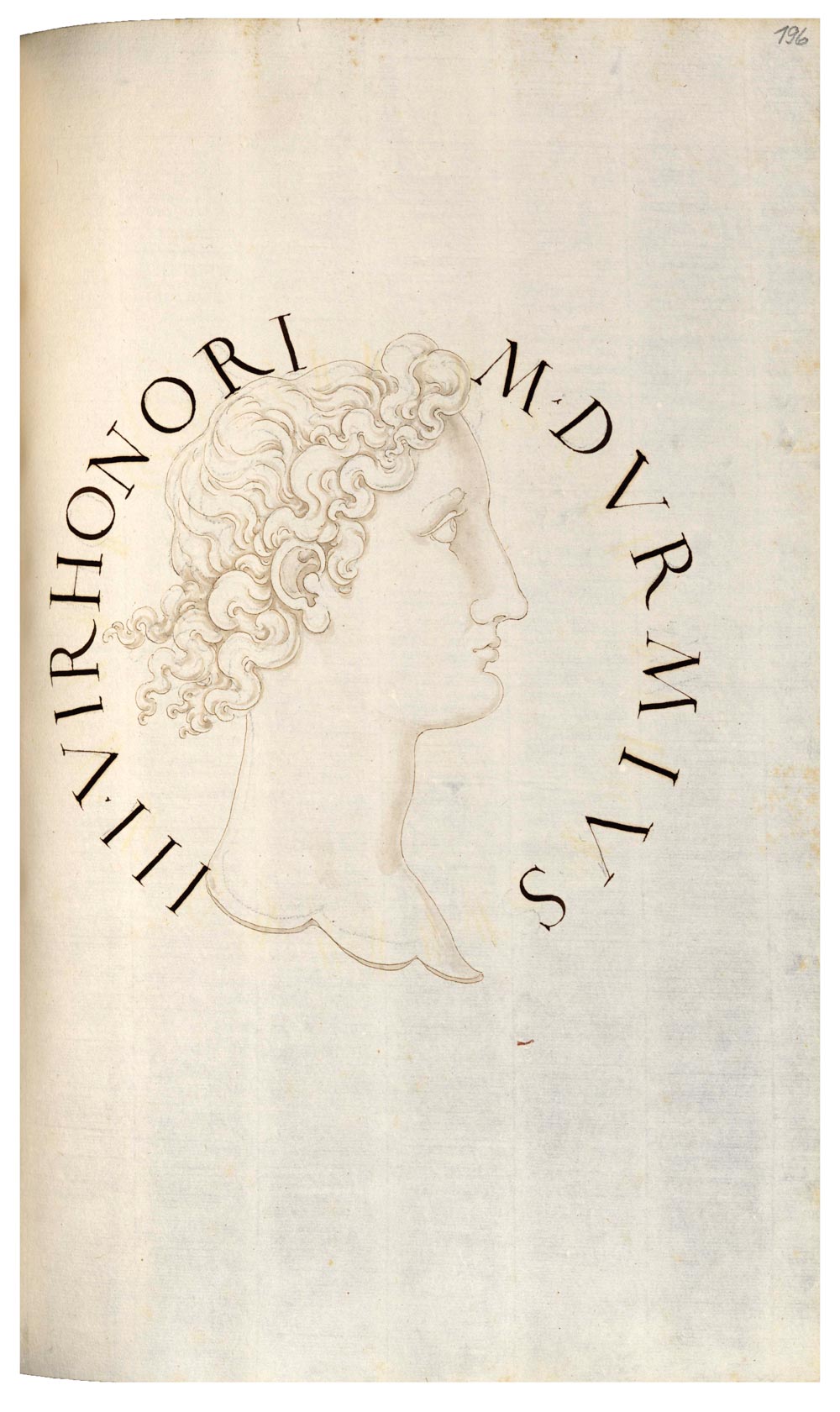
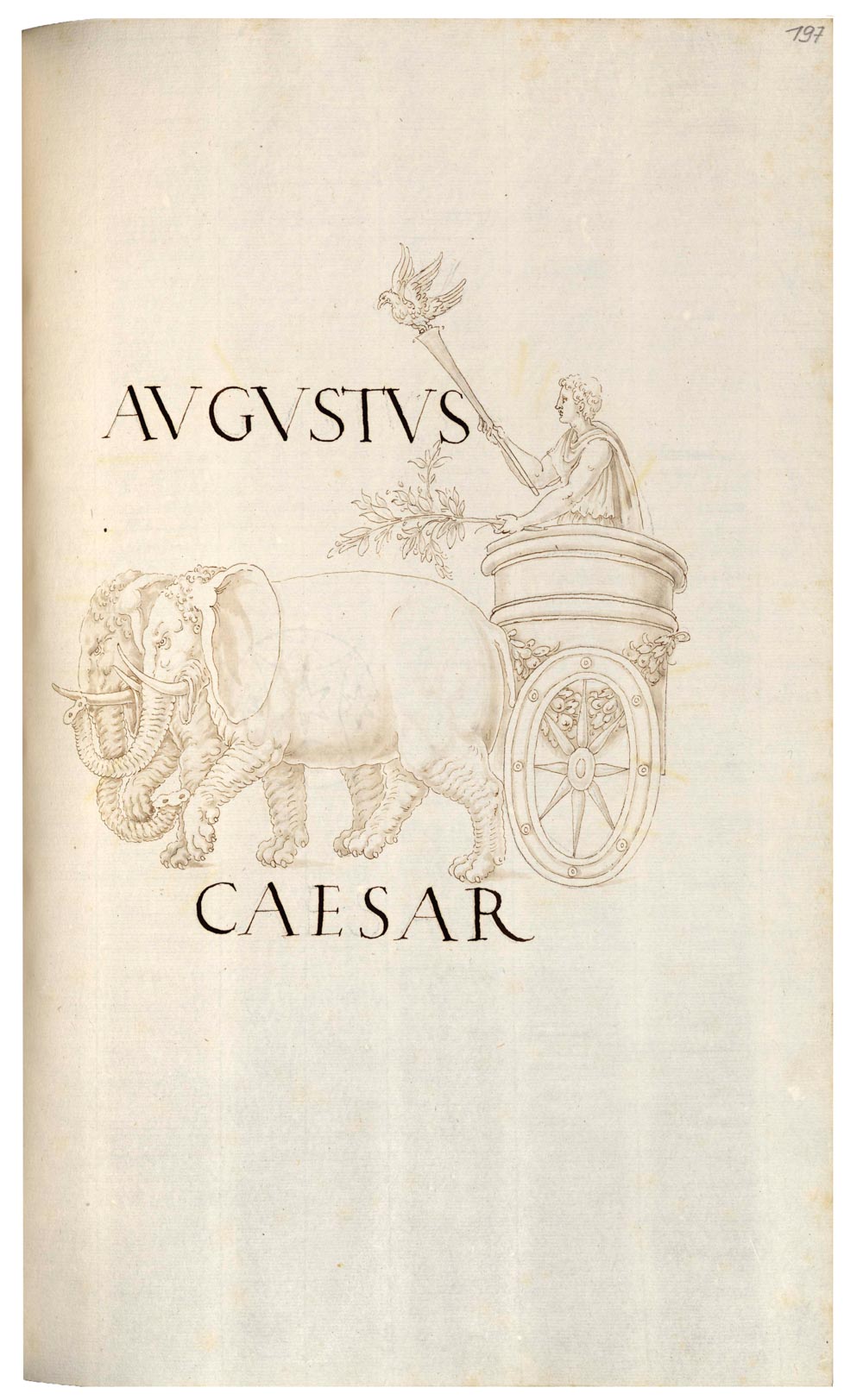
1.2
The second coin is to be found on fols. 188 (fig. 3a:
Augustus laureate, legend: S P Q R CAESARI AVGVSTO) and 189 (fig.
3b: two arches with two equestrians, legend: QVOD VIAE MVN
SVNT)[10]
in the fourth volume of the MaNO. It
is described in the second volume of the Diaskeué (fol.
159v no. 74). Strada states that the Doge of Venice (1554–1556),
Francesco Venerio, was the owner. Of the contemporary
antiquarians, Hubertus Goltzius (figs 4a and b: Caesar
Augustus pl. XLVII, b: pl. X)[11]
and Sebastiano Erizzo depict this coin while Strada describes
and depicts it – Erizzo only the reverse, but from the matching
description it is evident that he described the same coin as
Strada[12].
Vico only included a description of this coin but provided the
matching obverse in his Discorsi[13].
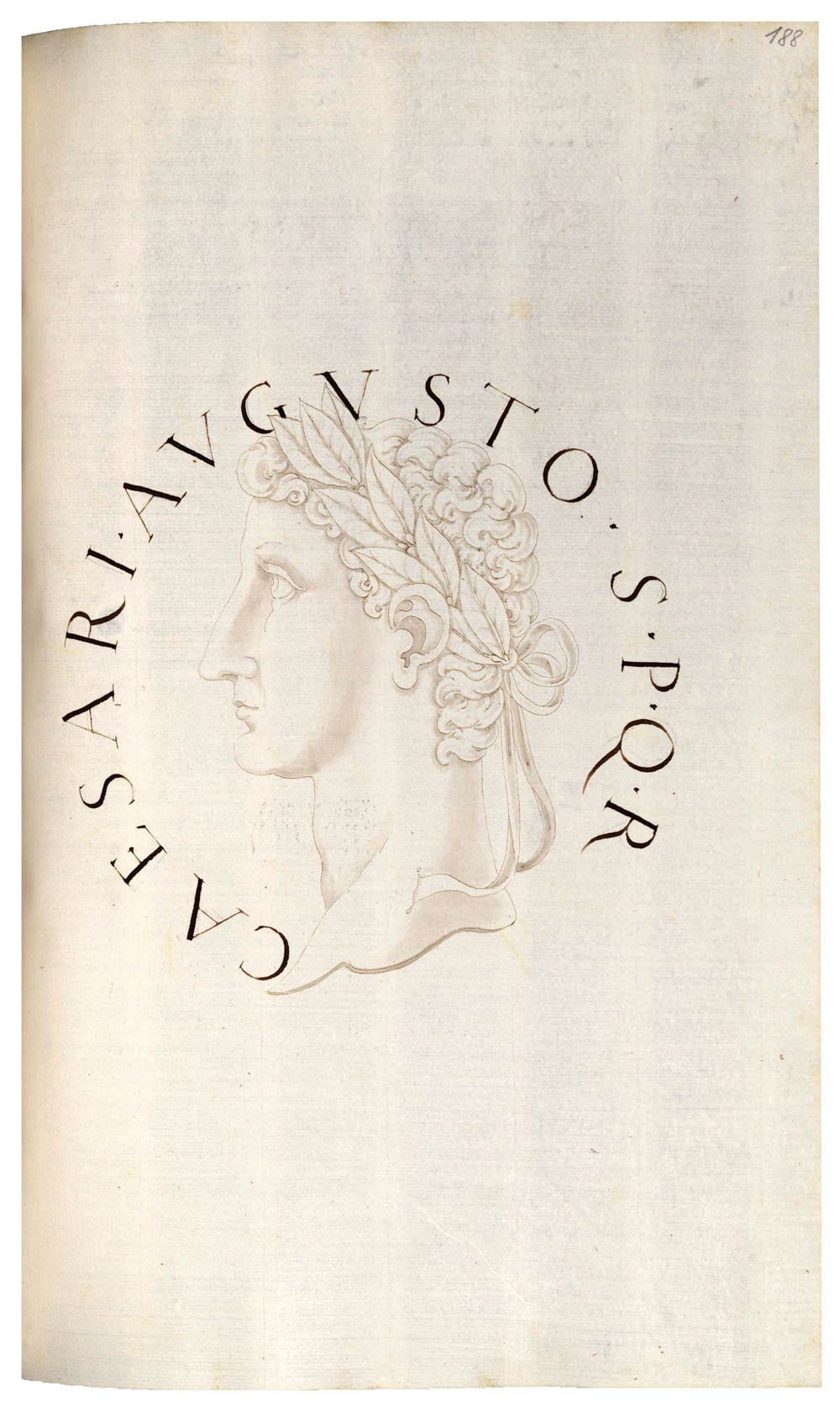
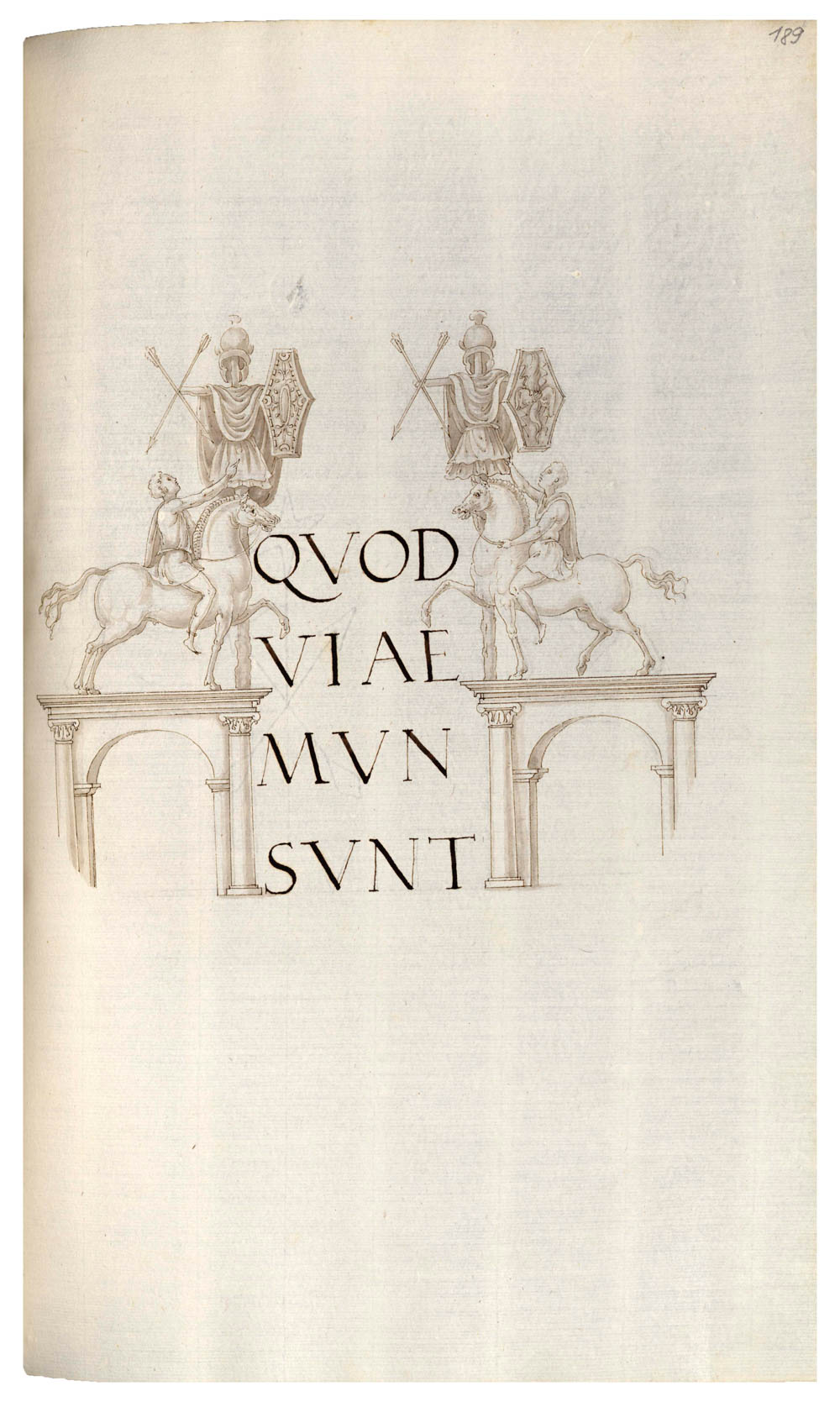
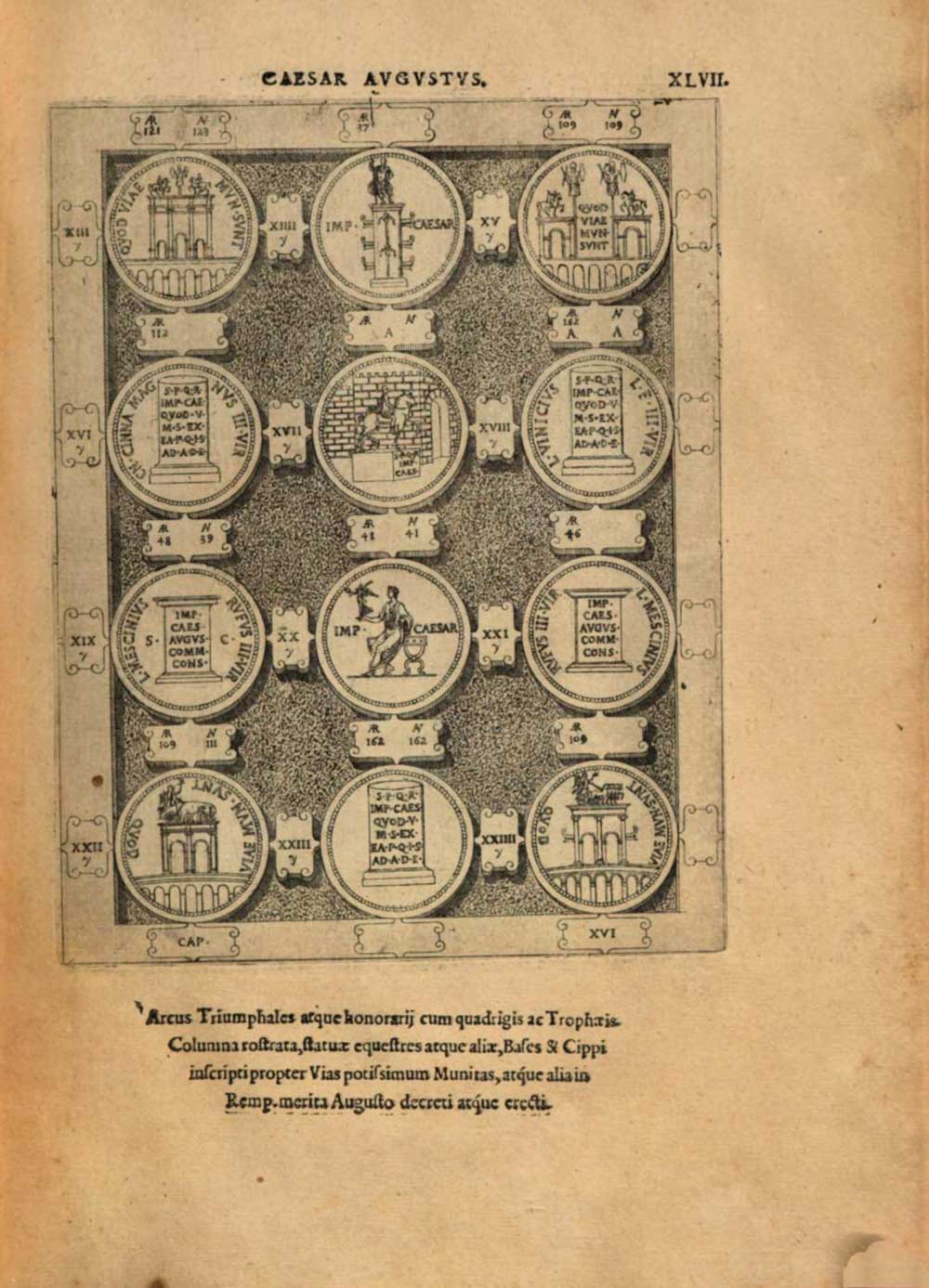
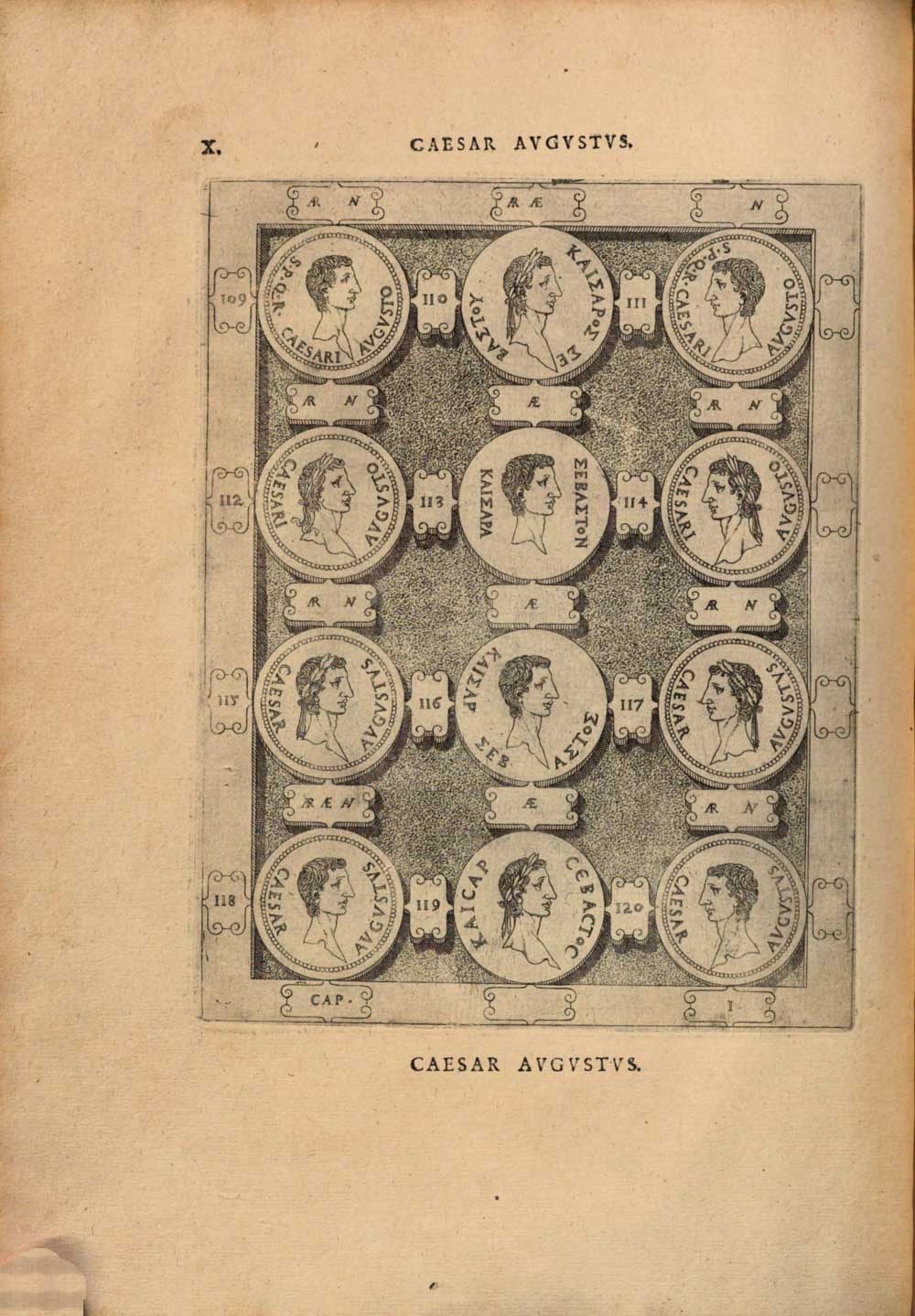
1.3
Of the third coin, both obverse and reverse are included
in the fourth volume of MaNO on fols. 258r (fig. 5a:
Augustus looking right, legend: CAESAR AVGVST) and 259r (fig.
5b: Imperator on platform, in front three officers
presenting a child, legend: IMP XIIII)[14].
The description can be found in volume 2 of the Diaskeué
on fol. 164r no. 96. Strada mentions as owner his mentor in
antiquarian-numismatic scholarship, the Lyon antiquarian
Guillaume du Choul (1496–1560), advisor to the French king and
bailiff of the Dauphiné[15].
With the exception of Goltzius, no other antiquarian illustrates
this coin. Goltzius depicts the reverse as it is in Strada, i.e.
with three officers standing before the emperor rather than one
officer as can be seen on the coin, on which the drawing is
based (figs 6a and b)[16].
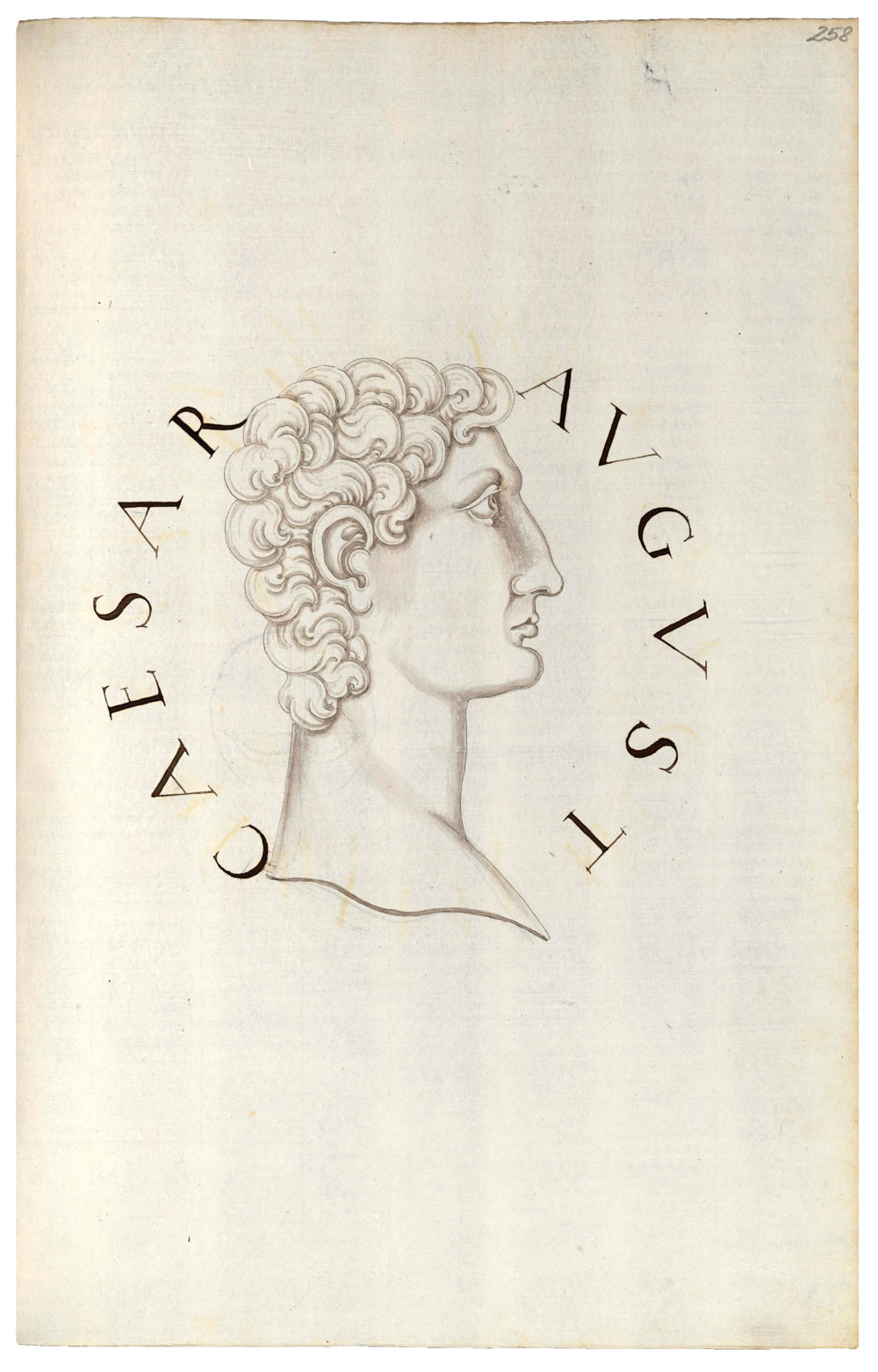
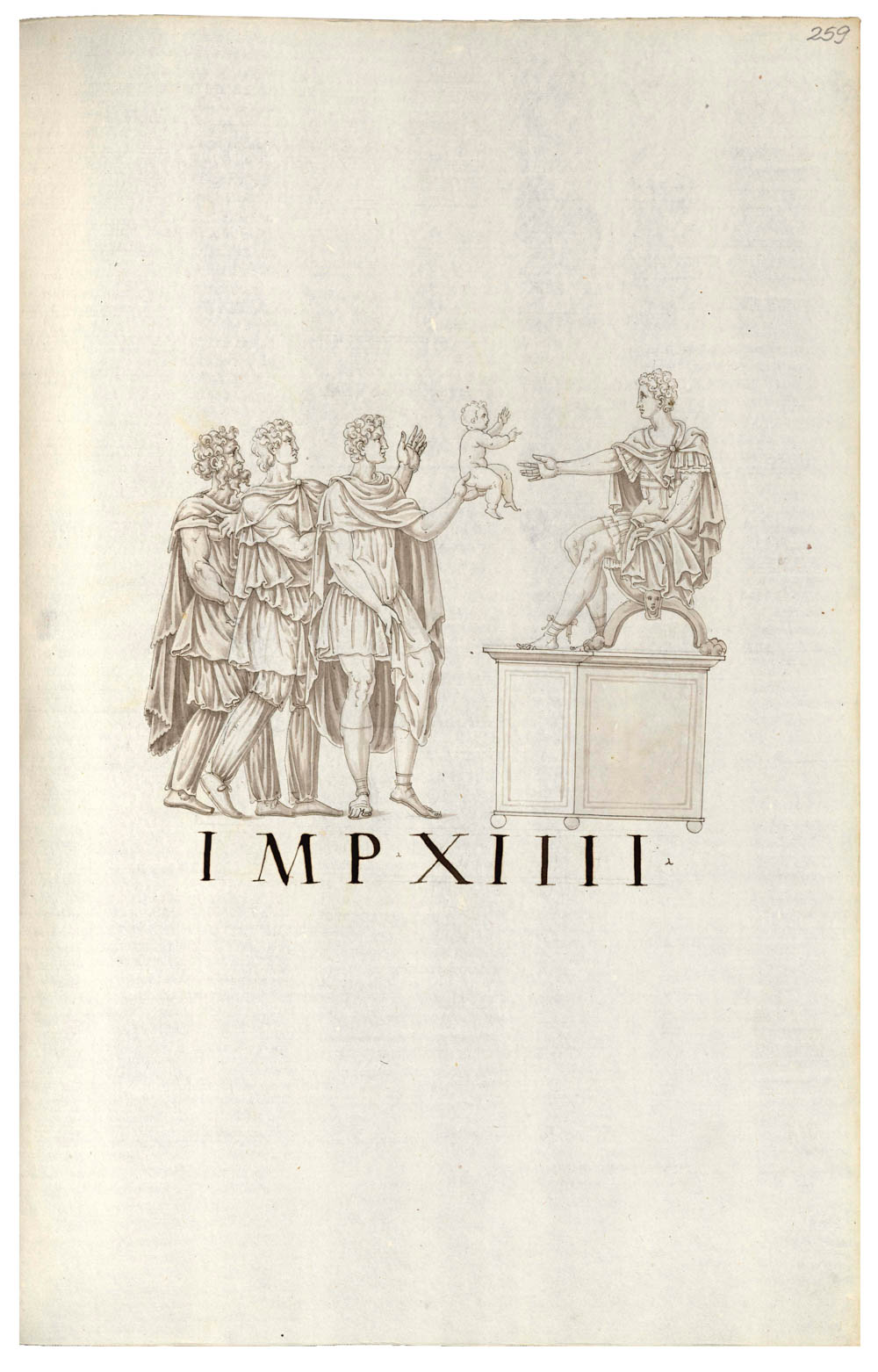
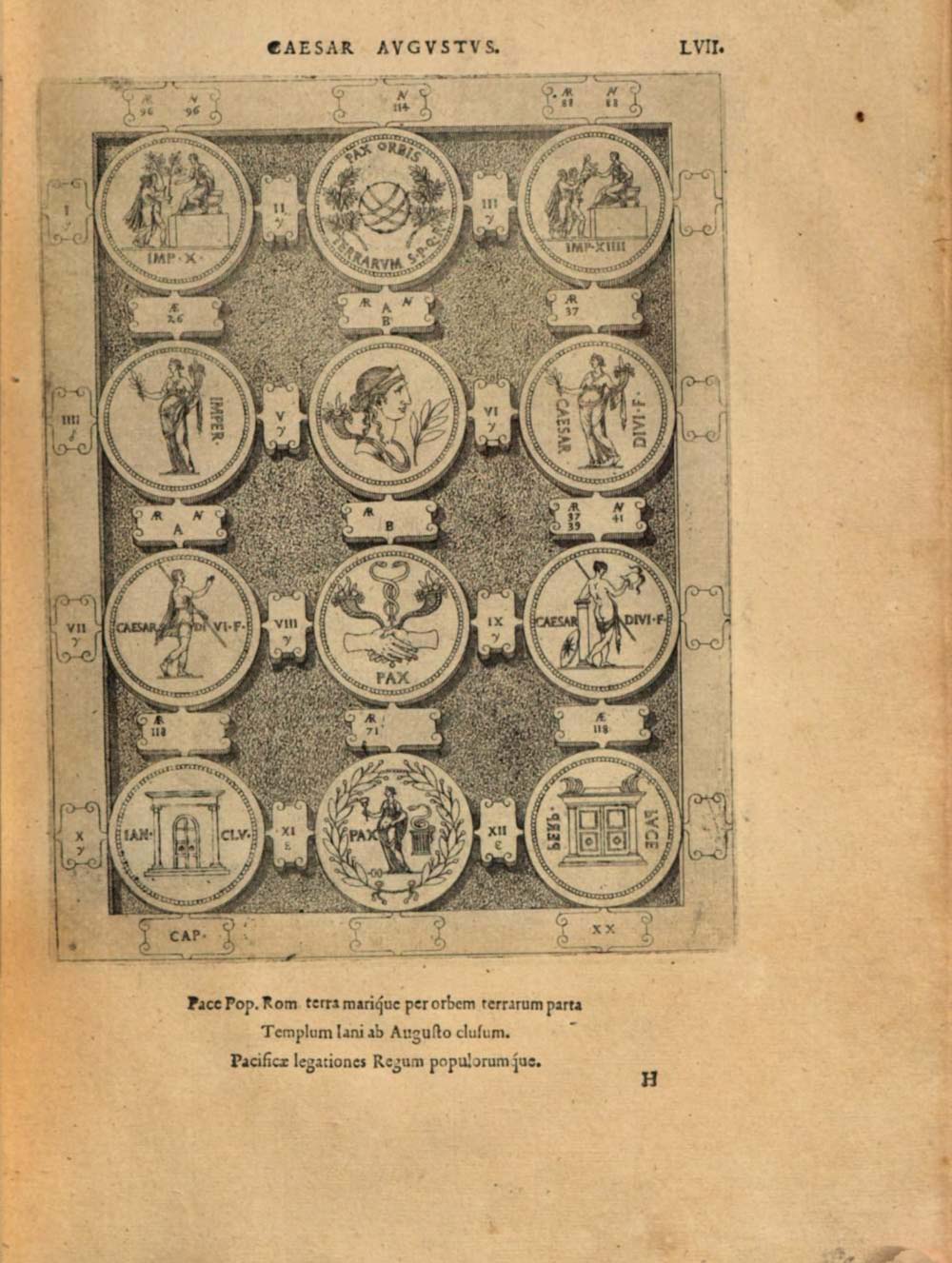
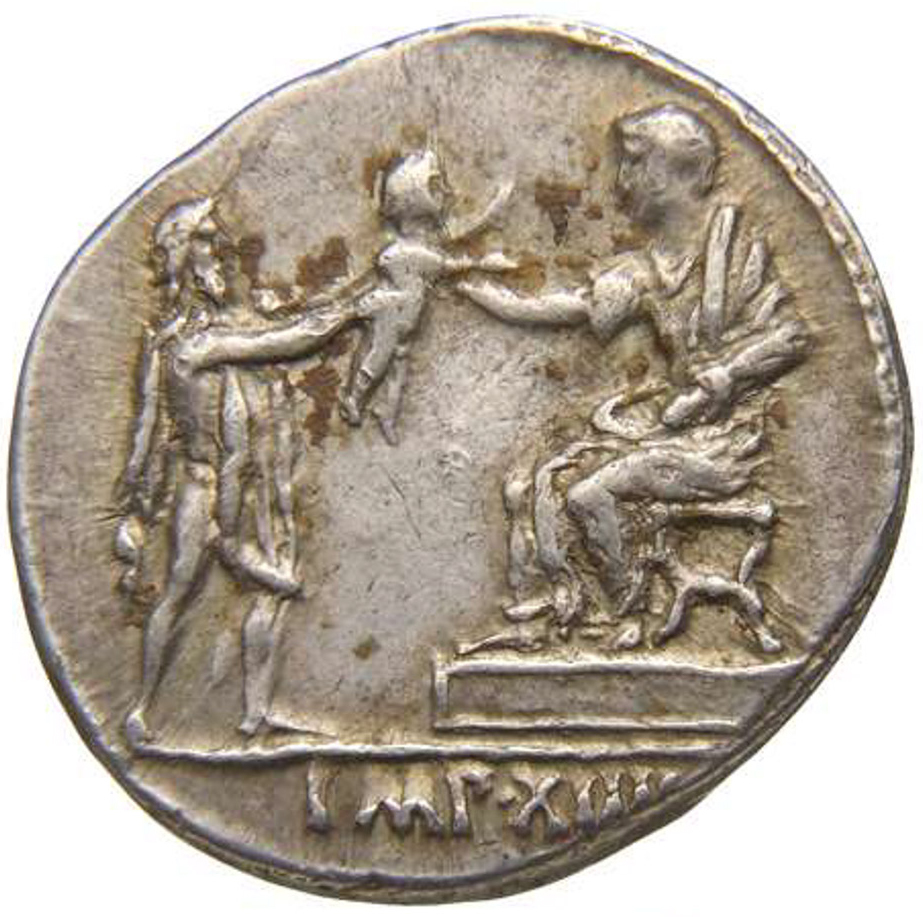
1.4
The fourth and last coin is illustrated on fols. 204r (fig.
7a: Augustus looking right, legend: CAESAR AVGVSTVS) and
203r (fig. 7b: Diana Venetrix, legend: IMP XI)[17]
in the fifth volume of the MaNO, with obverse and reverse
exchanged. The description can be found in the second volume of
the Diaskeué, fol. 169v no. 122, where the Bishop of
Tarragona and member of the Rota, Antonio Agustín, is named as
owner. Except for Vico (reverse only), no other antiquarian
includes it in his work[18].
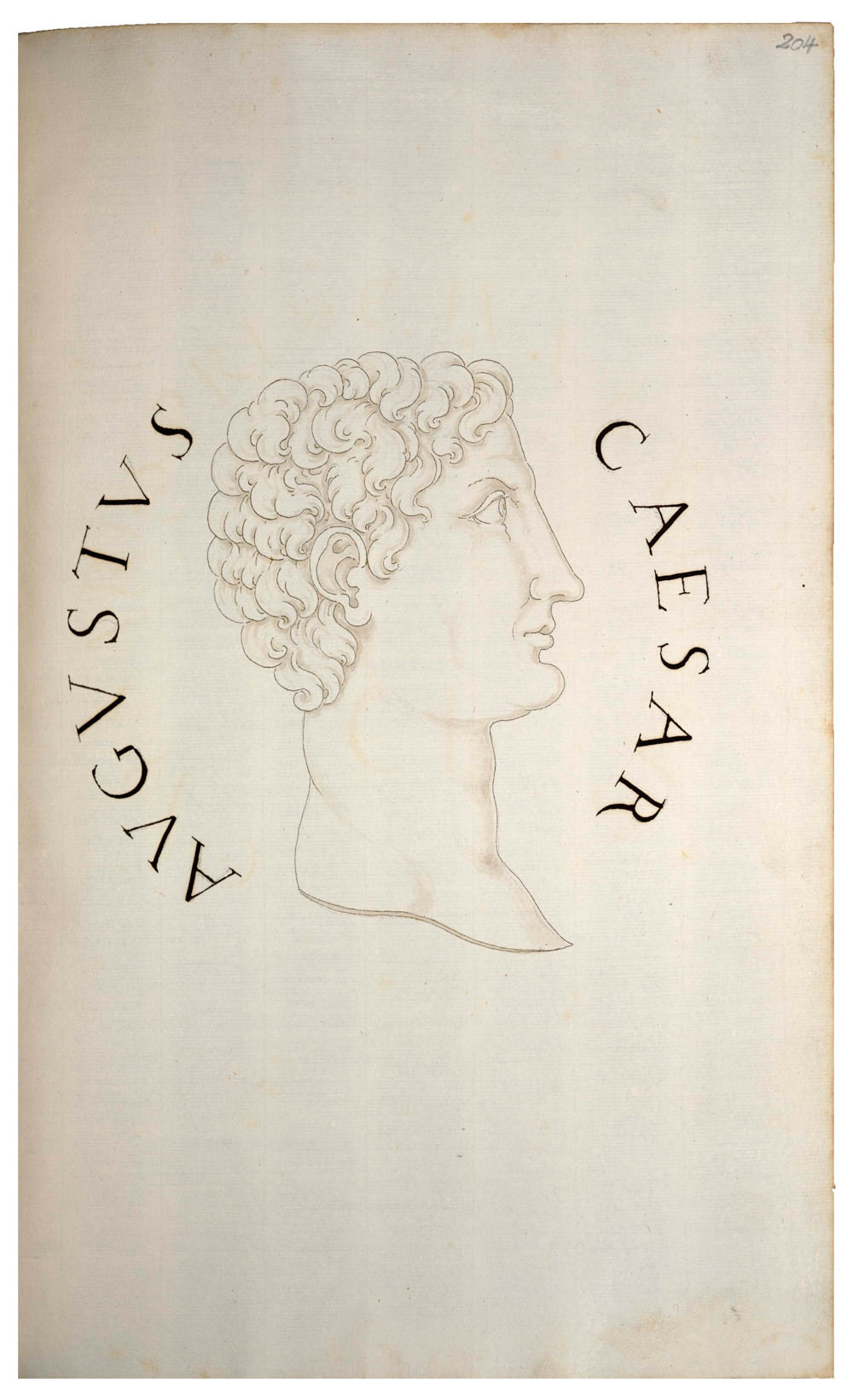
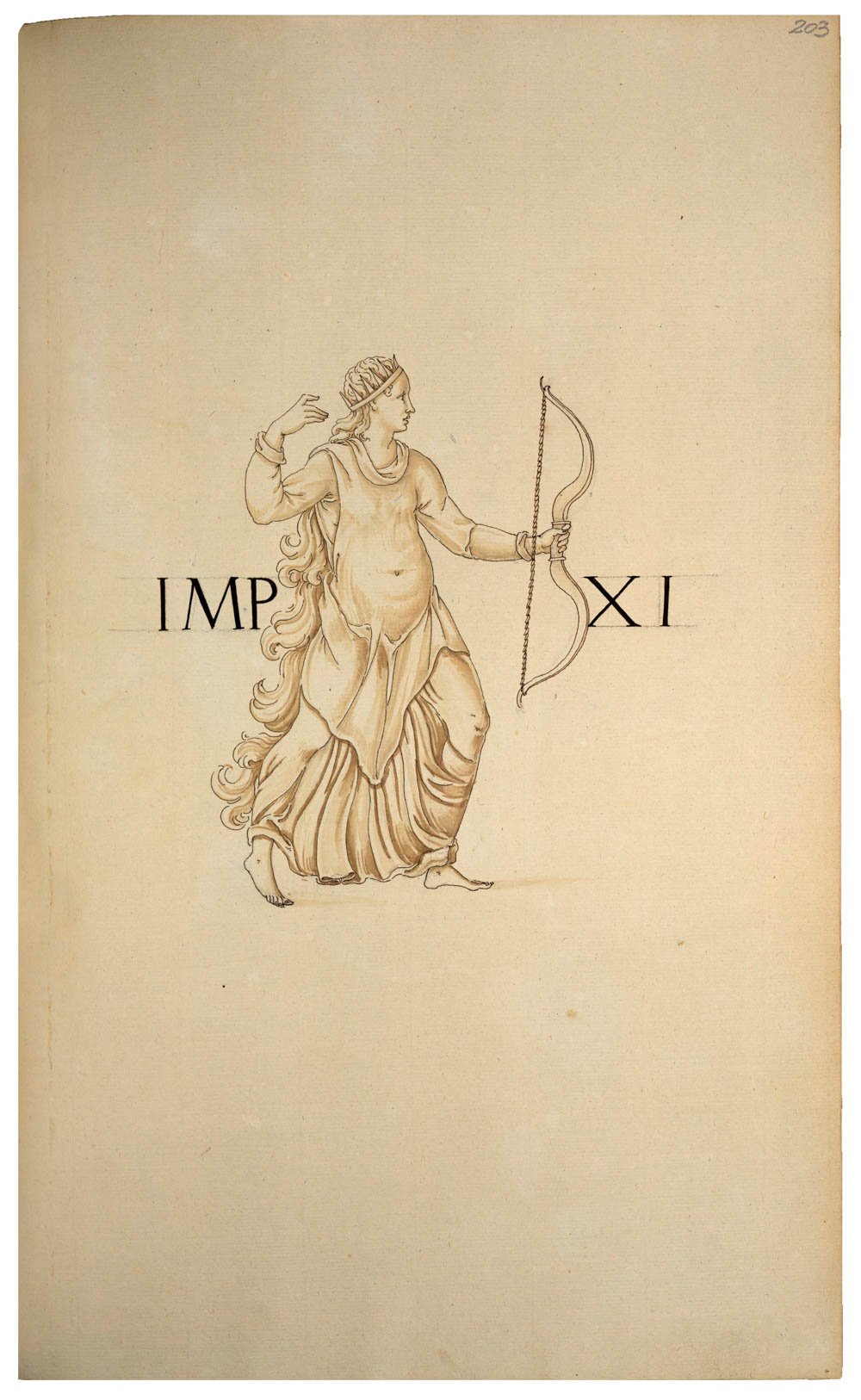
The second group includes six coin descriptions:
2.1 The first can be found on folio 272r (fig. 8a: Augustus looking right, legend: CAESAR DIVI F)[19] in the first volume of the MaNO and on folio 213r (fig. 8b: quadriga with palm branch, legend: C MARIVS C F PRO IIIVIR)[20] in the fourth volume. The description is included in the second volume of the Diaskeué on fol. 148r no. 15. Strada names Antonio Agustín as the owner. Enea Vico[21] and Hubertus Goltzius[22] obviously used the same source as Strada, which is confirmed by a similar error in the coin legend, i.e. C MARIVS C F PRQ III VIR instead of C MARIVS C F TRO IIIVIR on the original coin, Goltzius with the matching obverse[23]. Agustín and Erizzo do not present this coin; Ligorio however illustrates the coin with the correct obverse and reverse[24].
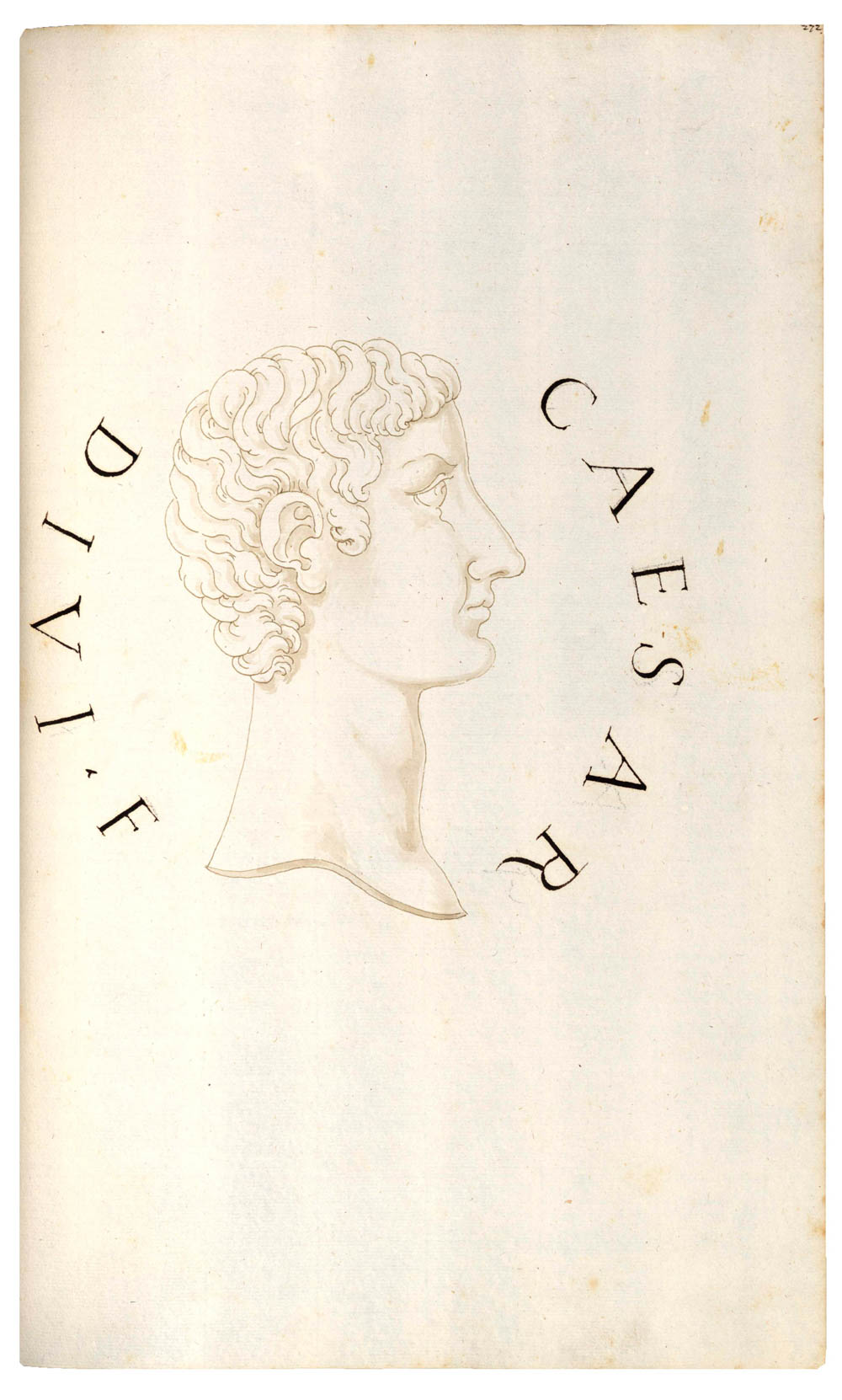
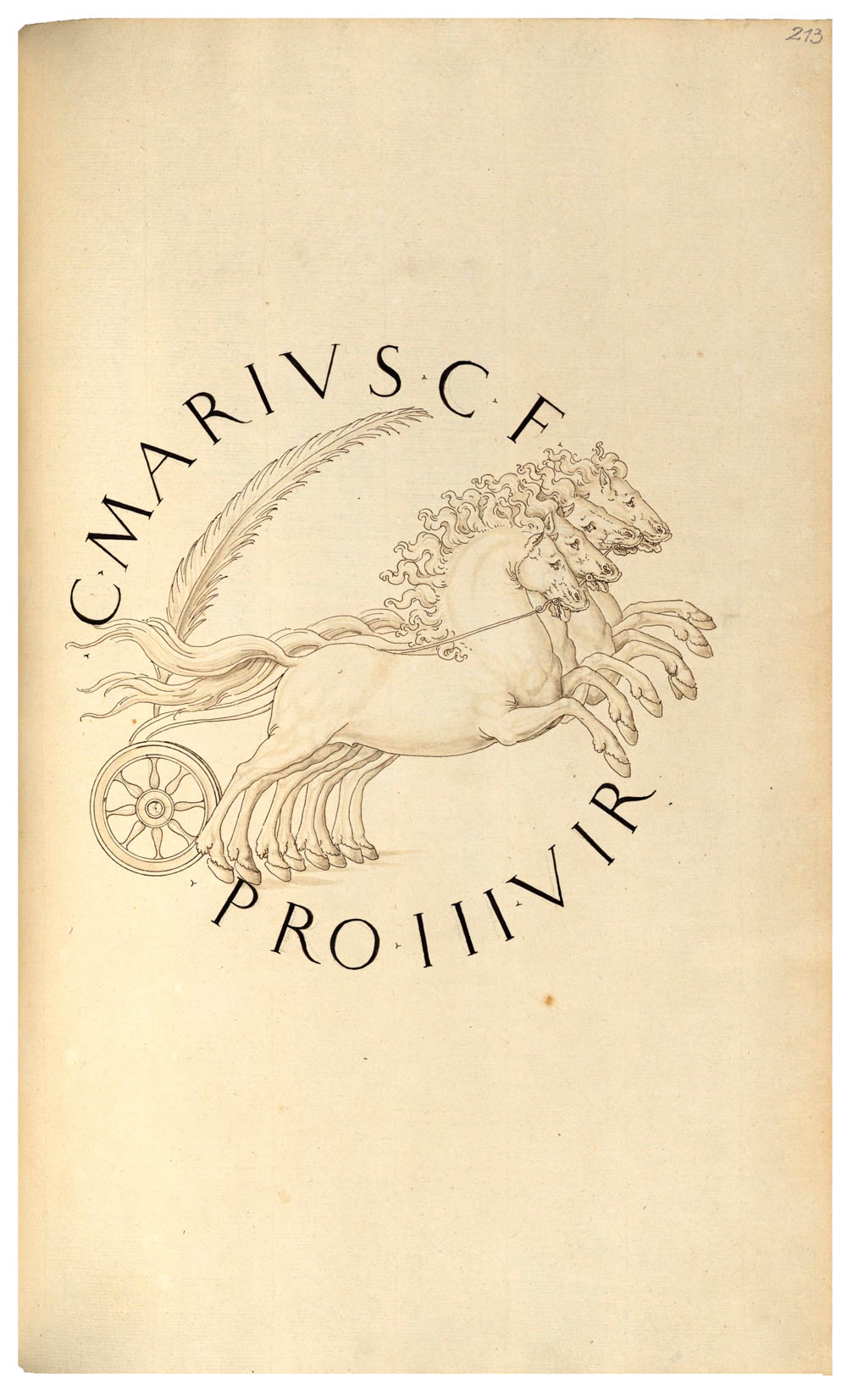
2.2 The second coin from this group is to be found on fol. 128r (fig. 9a: Augustus looking right, legend: IMP CAESAR) in the fourth volume and fol. 77r (fig. 9b: albogalerus between two shields, legend: P STOLO IIIVIR)[25] in the fifth volume of the MaNO. The description may be found in the second volume of the Diaskeué fol. 157r, no. 60. Achille Maffei, a Roman collector and antiquarian, is said to be the owner. Apart from Enea Vico (illustration of the reverse only)[26], Goltzius and Agustín depict it with the corresponding correct obverse[27].
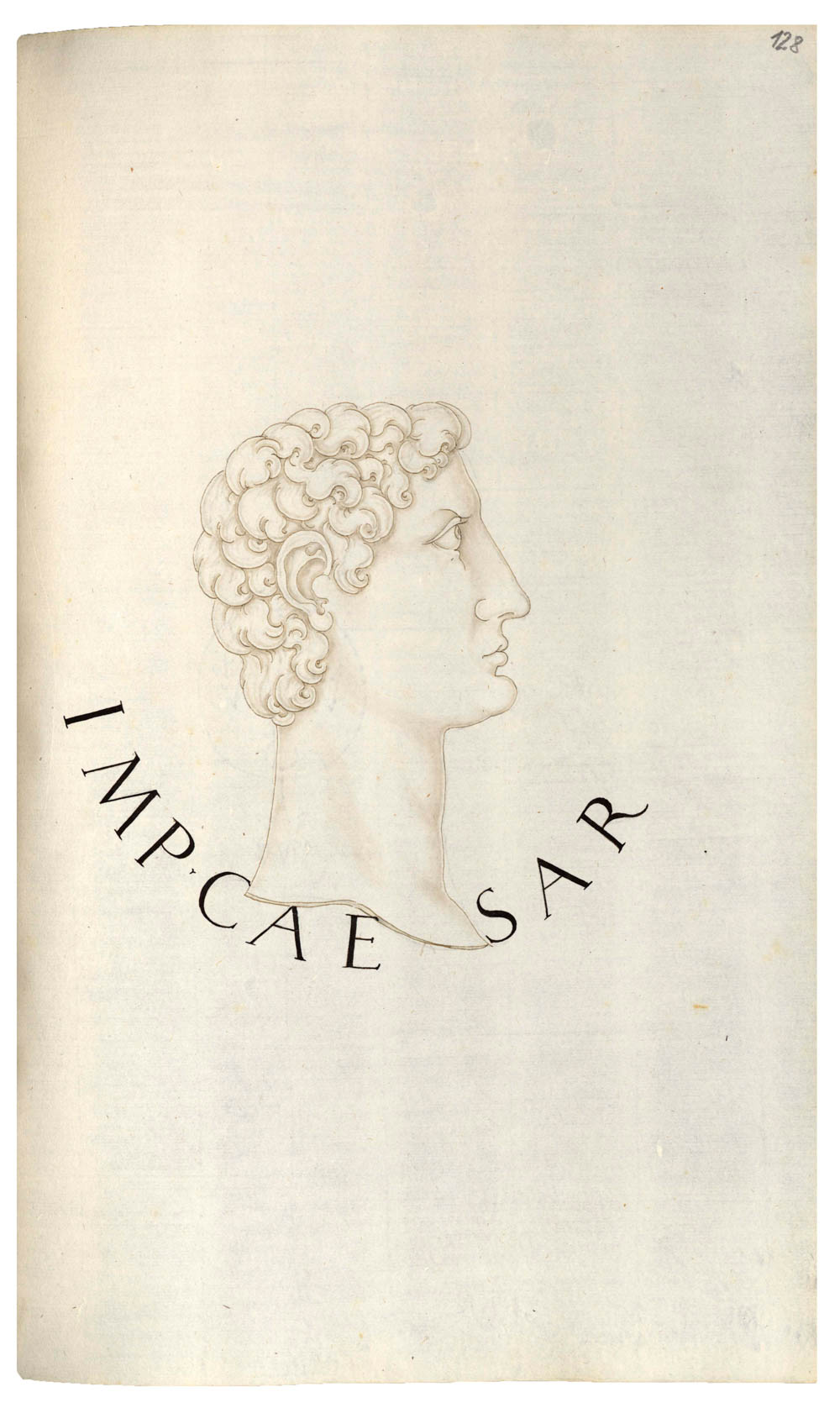
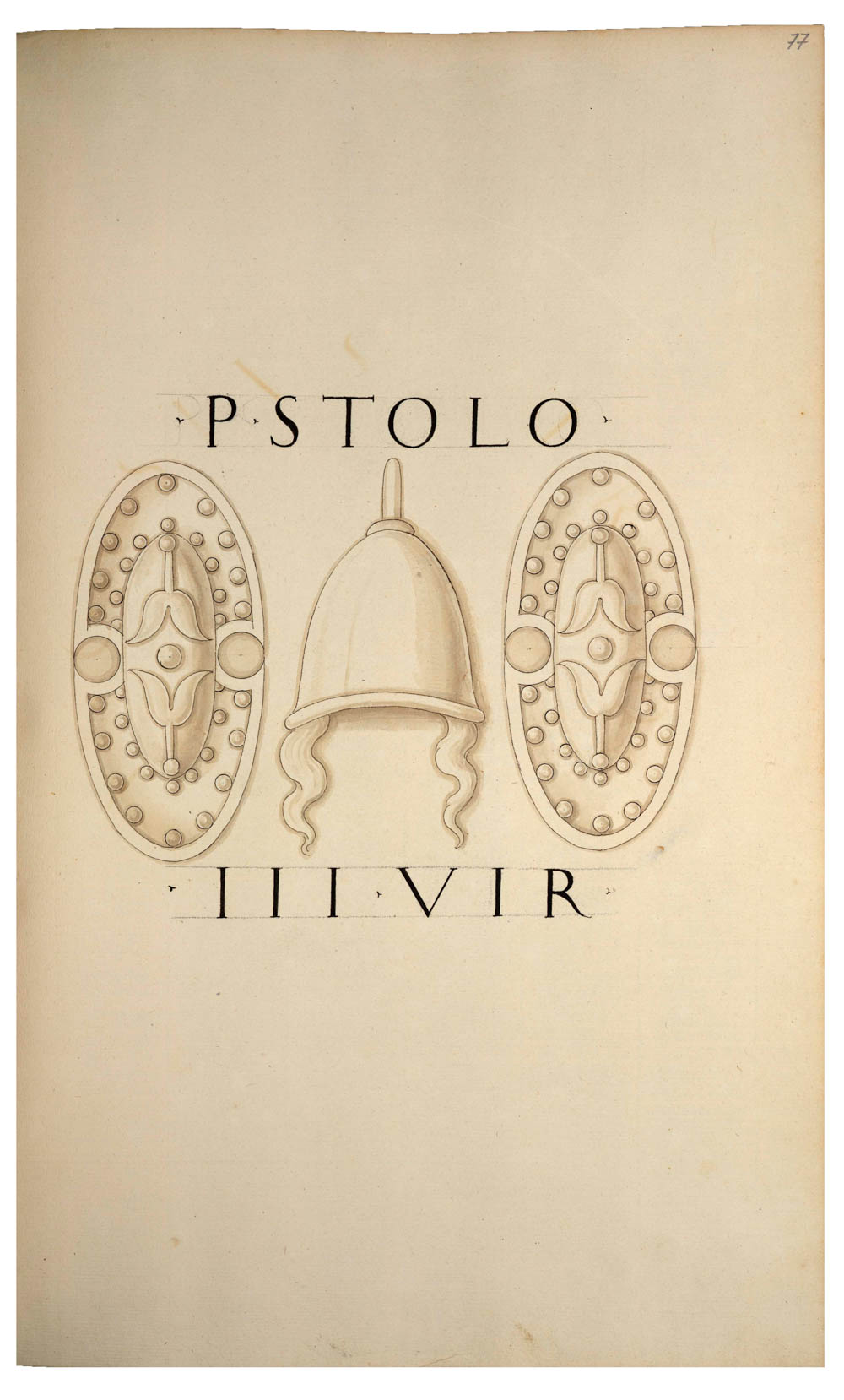
2.3
Of the third coin, only the reverse is shown on fol. 82r
(fig. 10: two togati, one resting on a shield, placing a
star on the other statue, which is holding a Victoria and spear,
legend: L LENTVLVS FLAMEN MARTIALIS)[28]
in the second volume of the MaNO. The
description of the entire coin is found in the Diaskeué
2, fol. 154v no. 48. Allegedly, this coin was in Strada’s own
collection. Enea Vico depicts only the reverse[29].
Goltzius and Ligorio reproduce it with the correct obverse in
their works[30],
Agustín and Erizzo omit it.
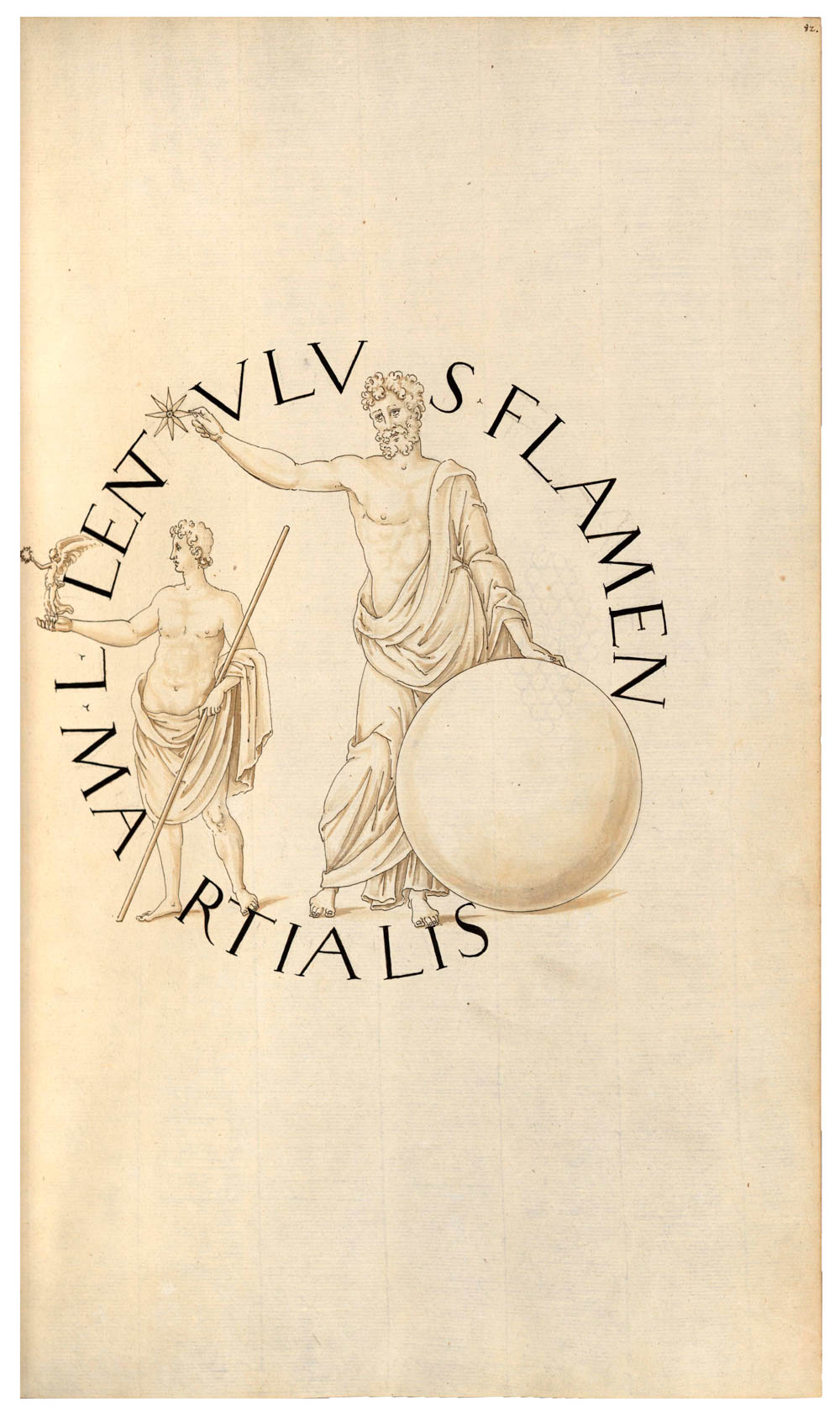
2.4
The fourth coin image – also merely depicting the reverse
– is to be found on fol. 21r (fig. 11a: quadriga with
statuettes, legend: CAESAR AVGVSTVS; b: denarius of
Augustus)[31]
in the fourth volume of the MaNO. The coin
is described in the second volume of the Diaskeué, fol.
154v no. 49. The description of the obverse says: Augustus
looking right, no legend is given. Again, Strada is named as the
owner. Vico also reproduces it with the missing abbreviation S C
in the legend[32]; i.e. he obviously copied the coin from Strada. None of the
above-mentioned antiquarians reproduced it.
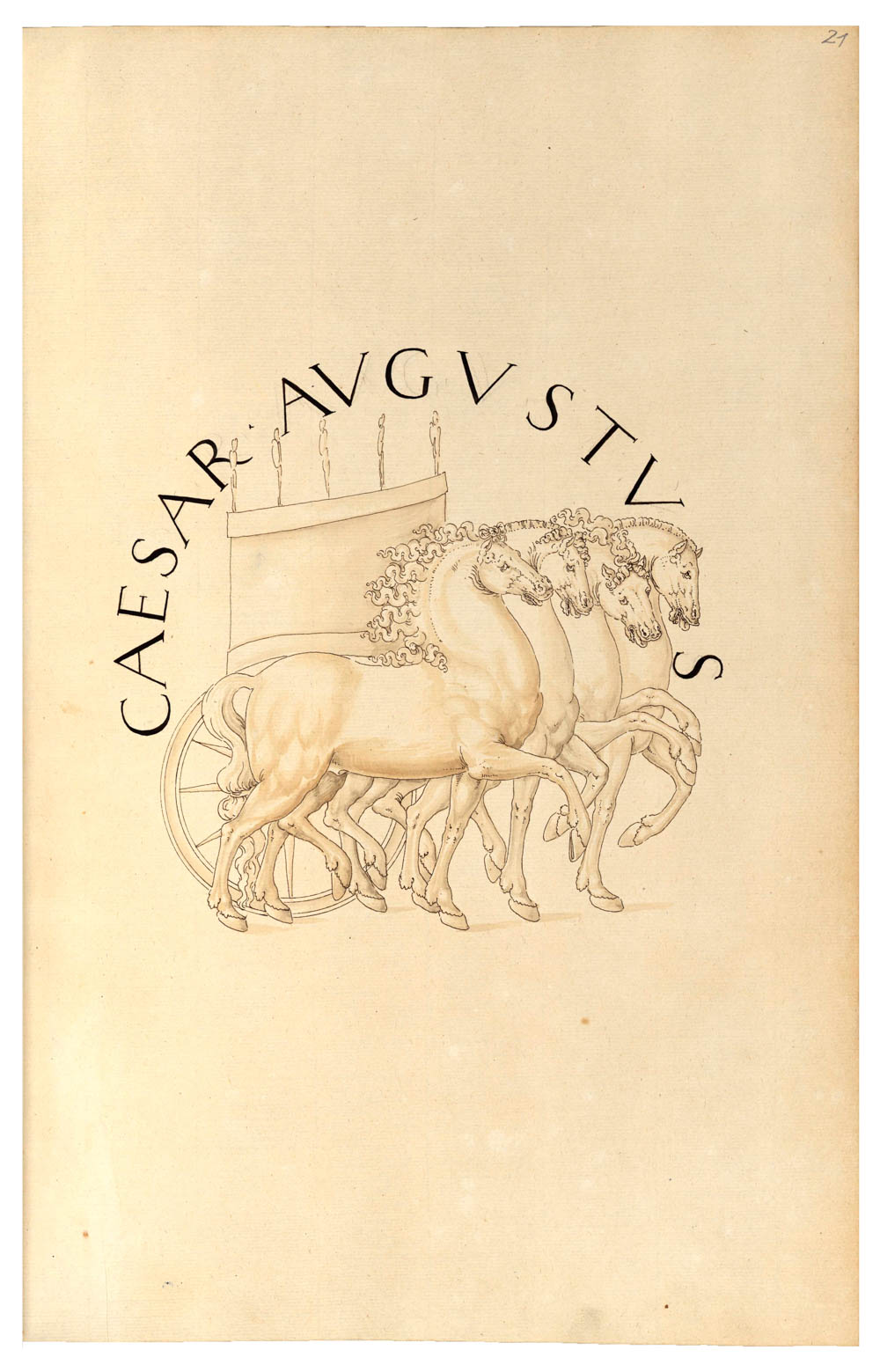
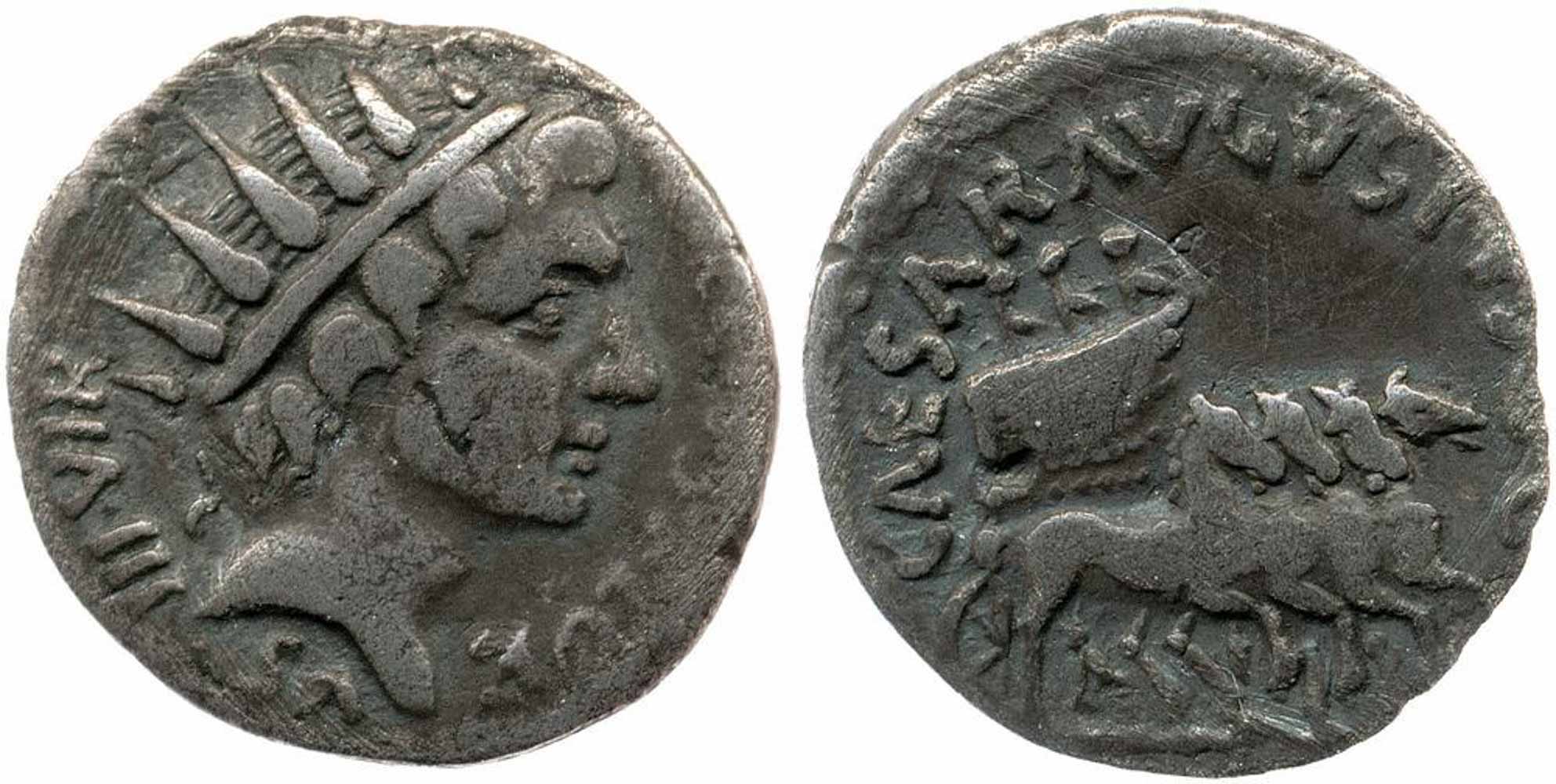
2.5
The fifth coin reverse – actually it is the obverse – can
be seen on fol. 57r in volume four of the MaNO (fig.
12a: Apollo with diadem and quiver, legend: C MARIVS PRO
IIIVIR)[33].
The description is in the second volume of the Diaskeué,
fol. 155r no. 50. The obverse is described as follows: Augustus
looking right, legend CAESAR AVGVSTVS. This piece also came from
Strada’s own collection. It was reproduced as a reverse by Vico[34].
The only other antiquarian to depict this coin is Goltzius (fig.
12b: Caesar Augustus pl. XXXI). He, as well, conceived it as
a reverse and combined it with another obverse[35]. The portrait is correctly recognized as that of Diana.
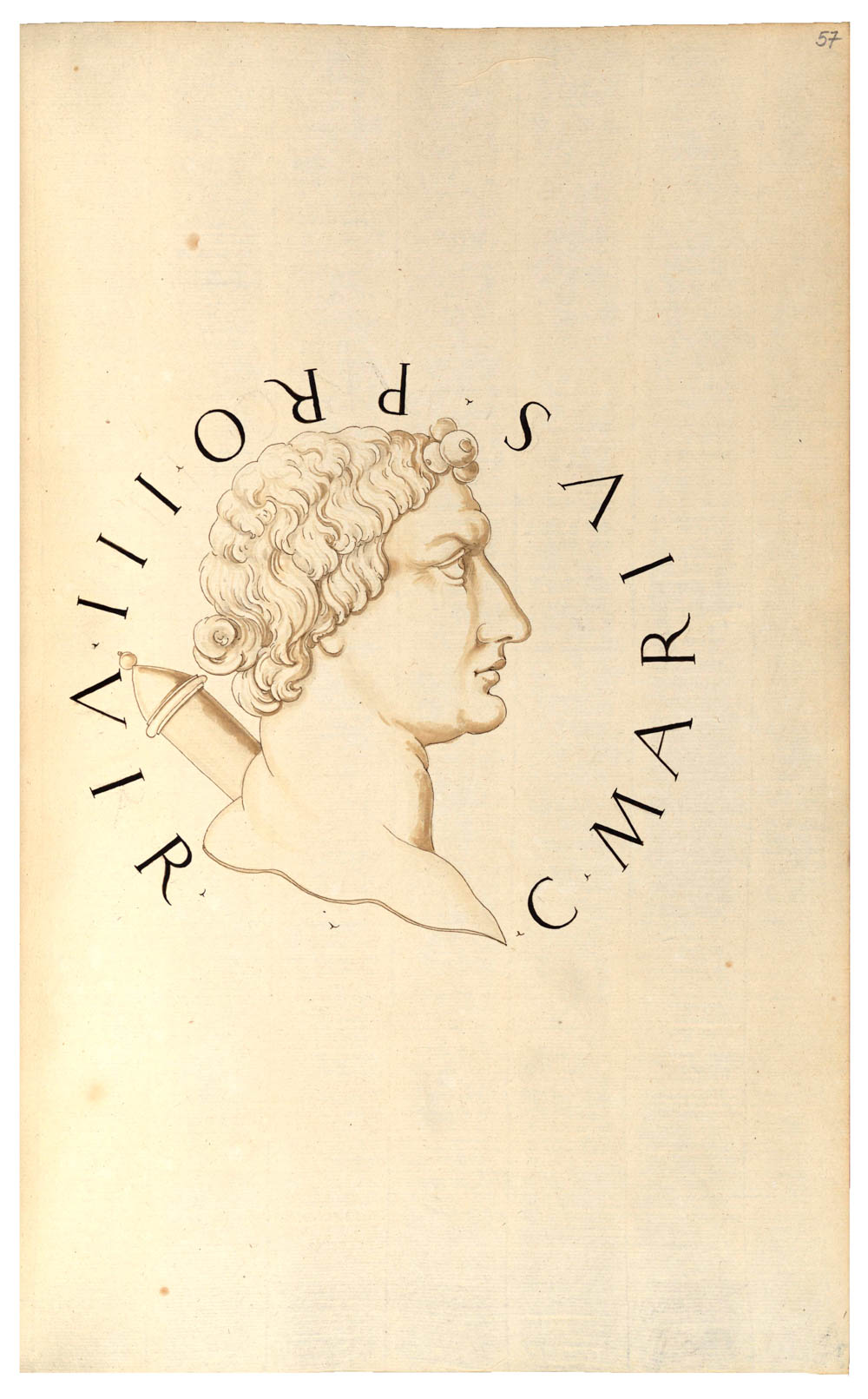
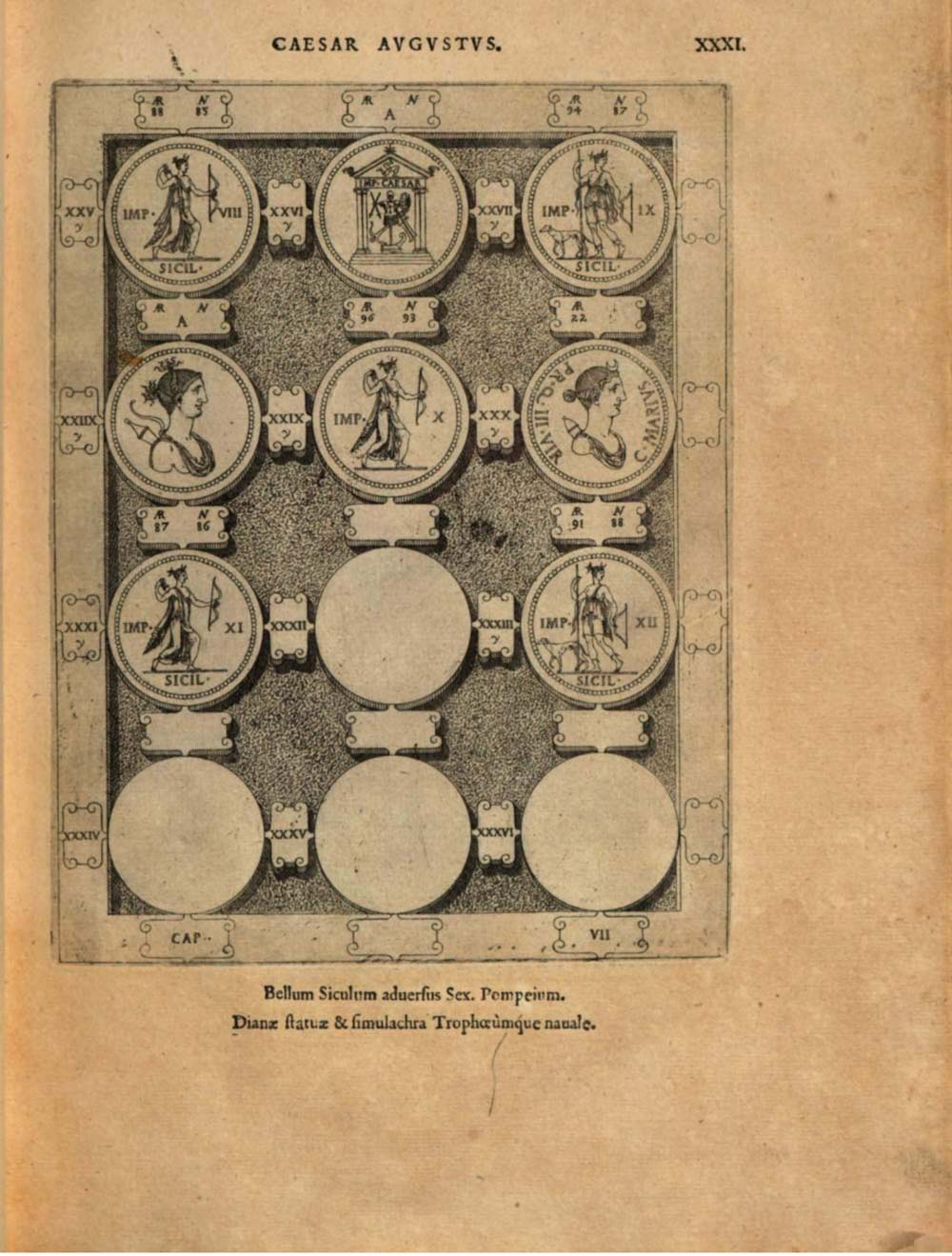
2.6
The reverse of the last coin in this category is
reproduced on fol. 71r (fig. 13: clypeus with gems,
legend: IMP CAESAR DIVI F)[36]
in the second volume of MaNO. The matching
description is listed in the second volume of the Diaskeué,
fol. 168r no. 115. The obverse is described as follows: Augustus
with helmet, looking right, without legend. Strada is mentioned
as the coin’s owner. In Vico only the reverse of the coin can be
found[37].
Erizzo reproduces it with the correct obverse[38];
so do Goltzius[39]
and Ligorio[40].
It is not included in Agustín.
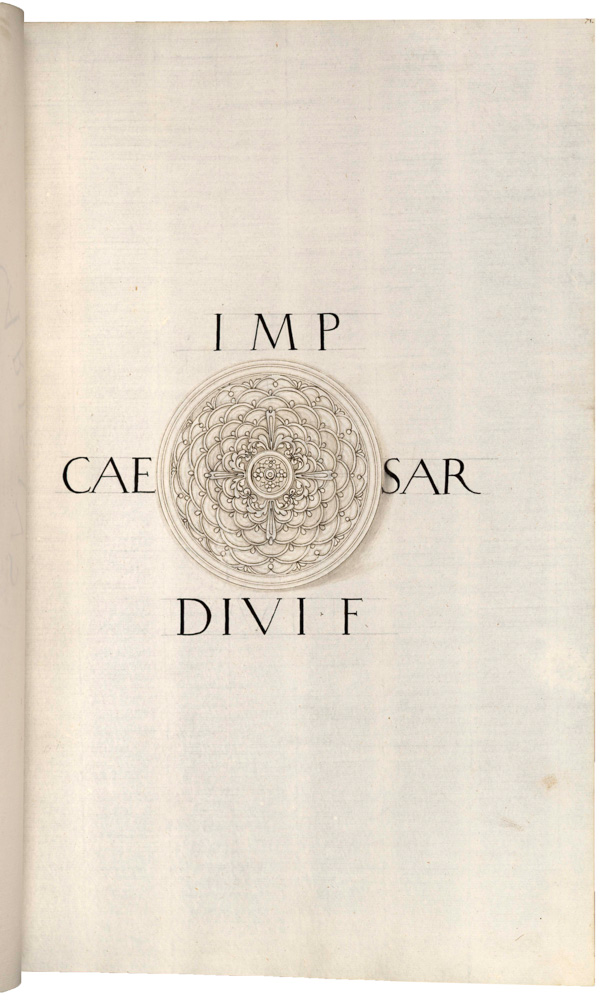
The third group includes four coins:
3.1
The first piece is included in the fifth volume of the
MaNO on fol. 4r (fig. 14a: Augustus looking right,
legend: CAESAR AVGVSTVS)[41]
and illustrated in the fourth volume of MaNO on fol. 174r
(fig. 14b: bust of Diana, legend: P PETRON TVRPILIANVS
IIIVIR)[42].
The description is found in volume two of the Diaskeué on
fol. 152 no. 34. It is presented as being in Strada’s
collection. In the MaNO fols. 174r and 175r (fig. 15a:
bust of Diana, legend: P PETRON TVRPILIANVS IIIVIR; b:
Augustus in elephant biga, legend: AVGVSTVS CAESAR)[43]
are correctly combined, i.e. fol. 174r is here correctly
presented as obverse and fol. 175r as reverse. This coin is
illustrated in Vico in the edition of 1554 i.e. Omnium
Caesarum; he mistook the obverse with the image of Diana for
the reverse, exactly as happened in Strada[44].
Goltzius, however, understood both sides of the coin described
by Strada as reverses[45].
Agustín and Erizzo did not reproduce this coin. Ligorio depicted
it correctly, as it was presented in the MaNO[46].
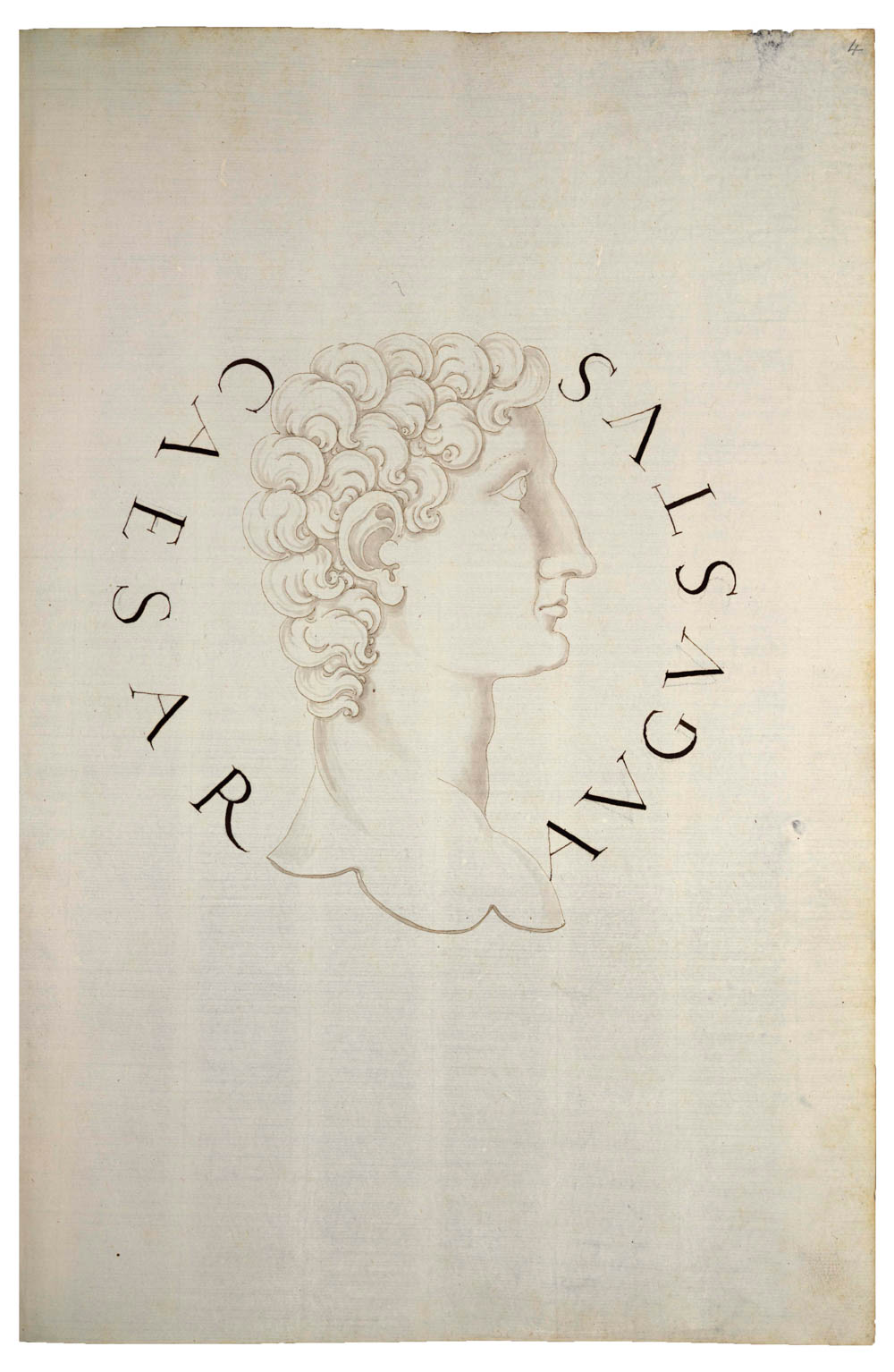

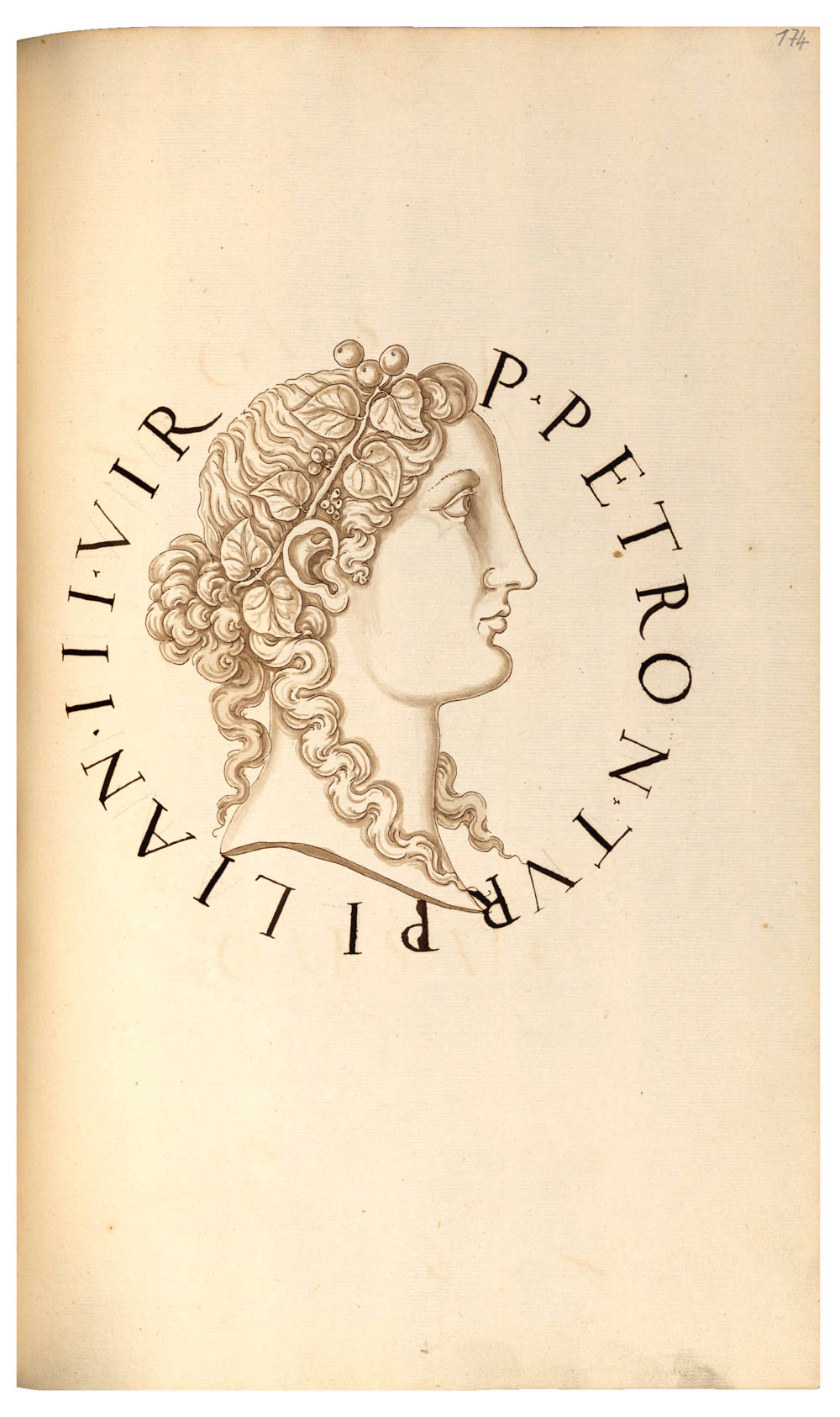
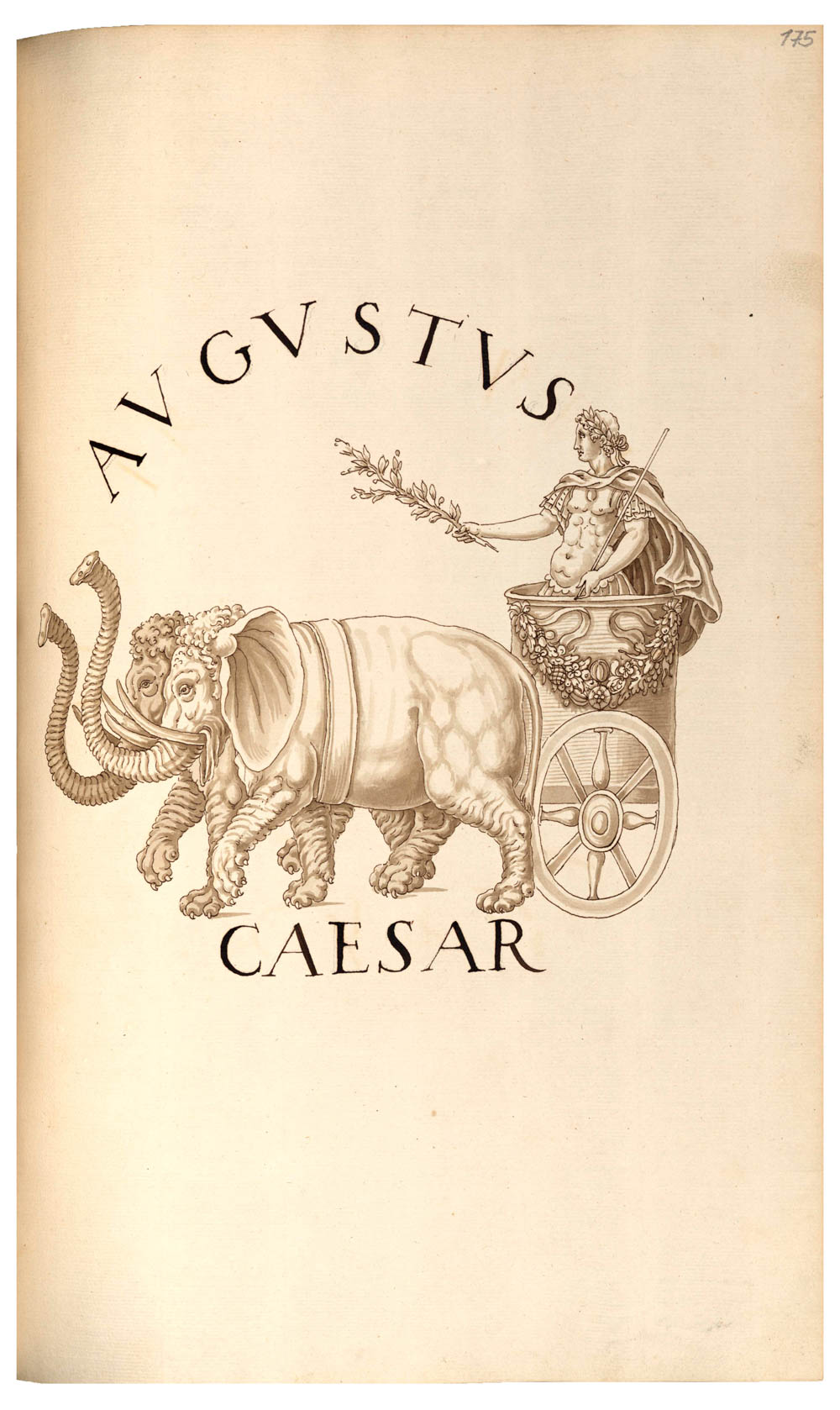
3.2
Strada confused the reverse with the obverse in the case
of the second coin – also included in the fifth volume of the
MaNO on fol. 40r (fig. 16a: Augustus looking left,
legend: CAESAR AVGVSTVS)[47]
and in the fourth volume on fol. 22r (fig. 16b: Antonius
and Lepidus, legend: IMP ...)[48].
It is described in the second volume of the Diaskeué,
fol. 152r no. 35. Strada was the owner of this coin. In the
Diaskeué, the coin on fol. 22r is described as reverse but
correctly linked in the MaNO as obverse to the following
coin illustration on fol. 23r (fig. 17a: Antonius and
Lepidus, legend on drawing: IMP P P DIVI F;
fig. 17b: Crocodile
in front of palm tree, legend: COL NEM)[49].
Vico depicts this reverse only in the 1554 edition of his book[50].
Sebastiano Erizzo, Hubertus Goltzius, Antonio Agustín and Pirro
Ligorio reproduce this coin with obverse and reverse correctly
linked as in the MaNO[51].
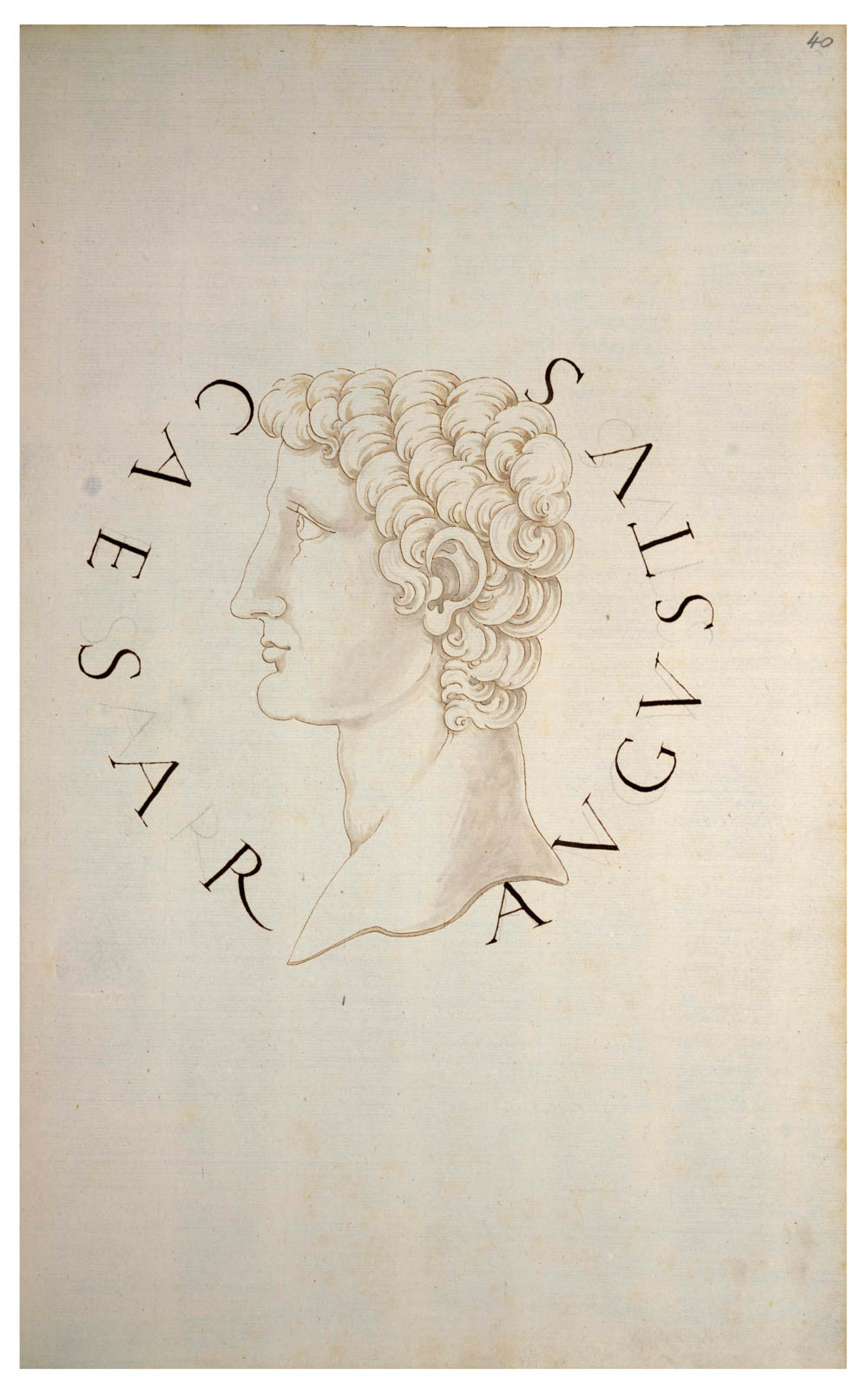
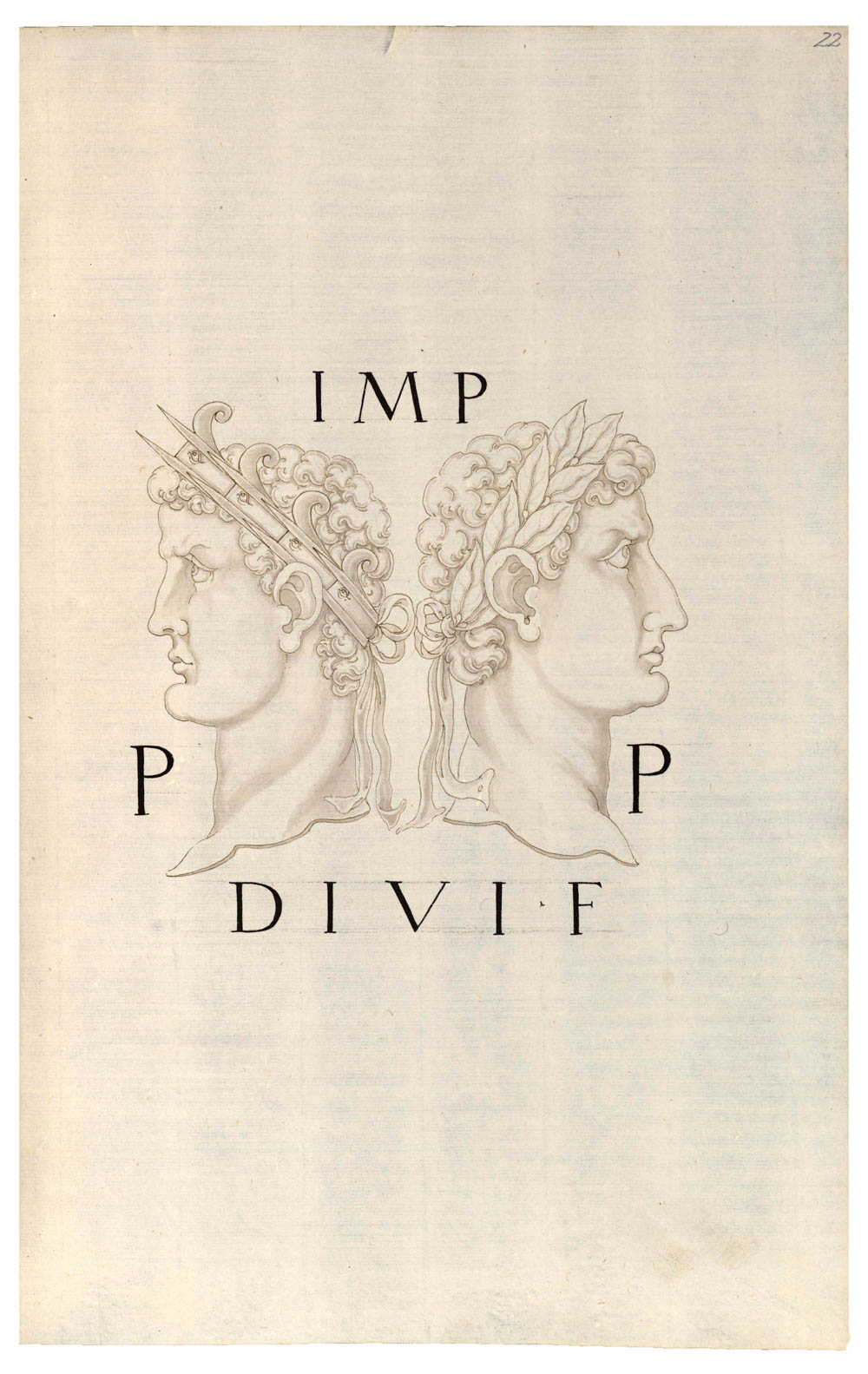
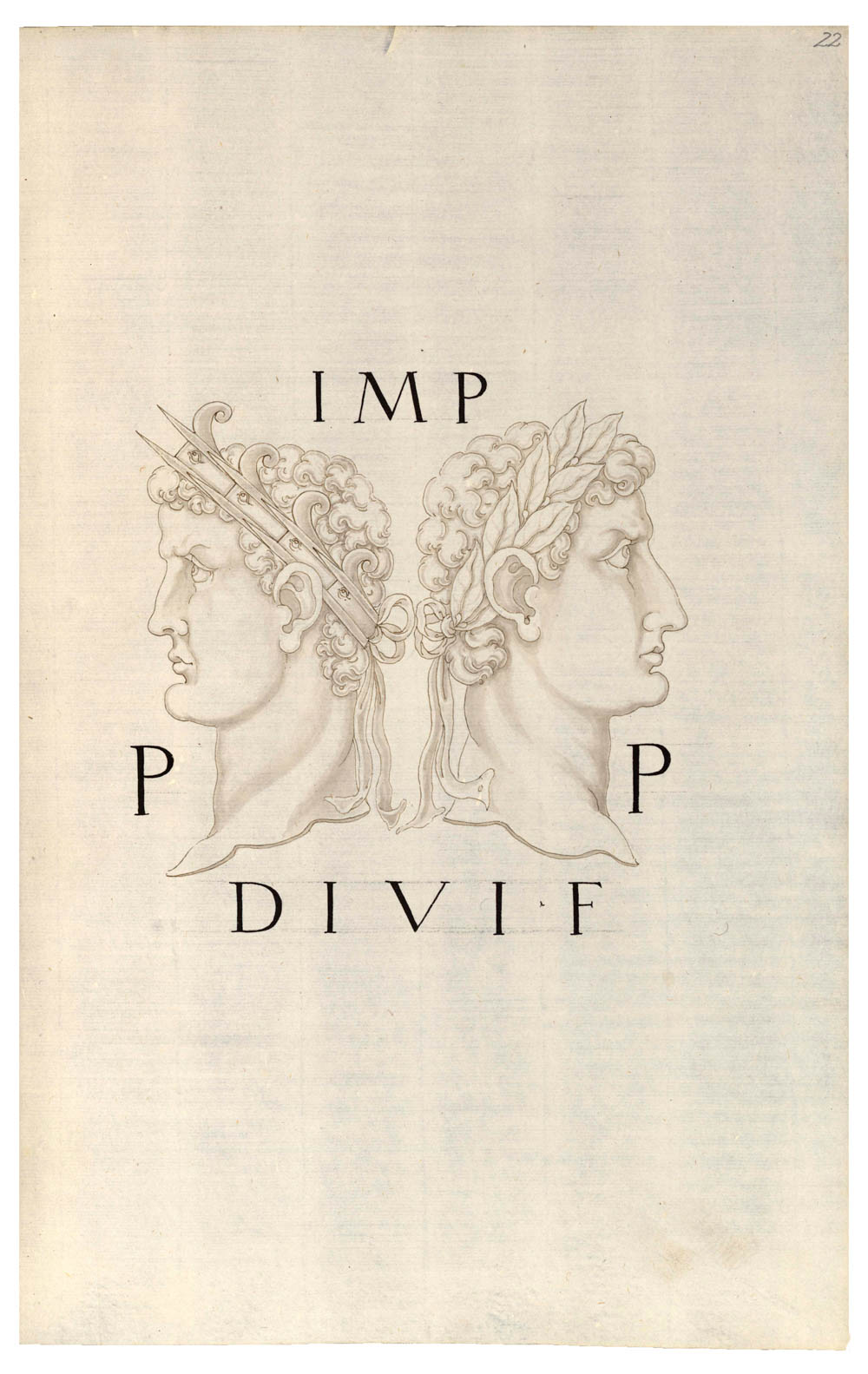
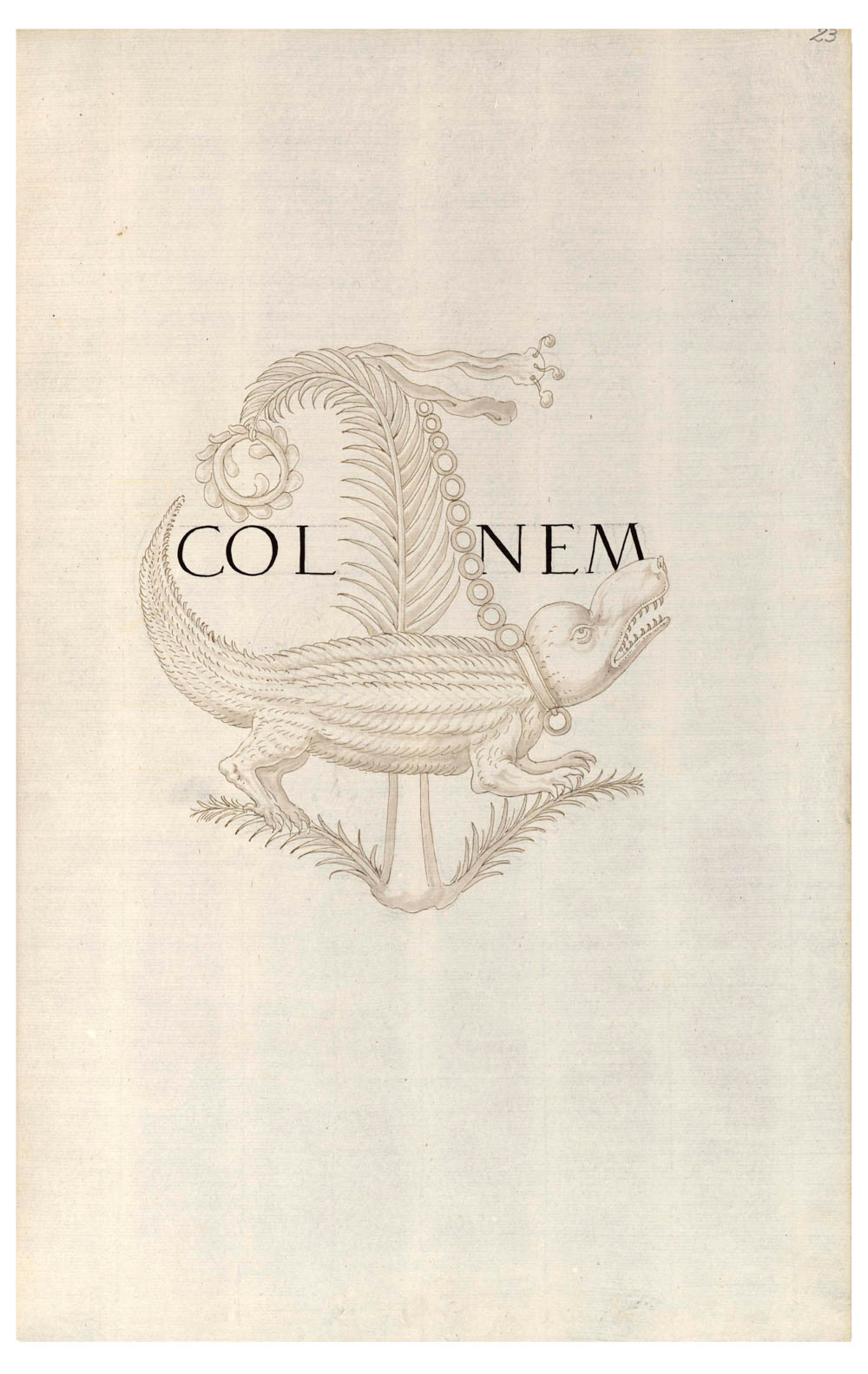
3.3
Of the third, non-existent coin, only the reverse is
shown in the MaNO in the second volume on fol. 106r (fig.
18a: arch of Augustus with quadriga, legend: IMP IX TR POT V
S P Q R SIGNIS RECEPTIS)[52].
The description can also be found in the second volume of the
Diaskeué on fol. 155r no. 51. The obverse is described but
not reproduced in the MaNO: Augustus looking right, no
legend is given. Again, Strada names Antonio Agustín as the
owner. The correct obverse can be found in the MaNO on
fol. 105r (fig. 18b: Augustus looking right, legend on
drawing: IMP IX TR PO)[53].
Vico also reproduces the arch[54].
It is not found in the works of Erizzo and Agustín. Goltzius
links it to an incorrect obverse[55].
Ligorio depicts the coin in the correct combination of obverse
and reverse[56].
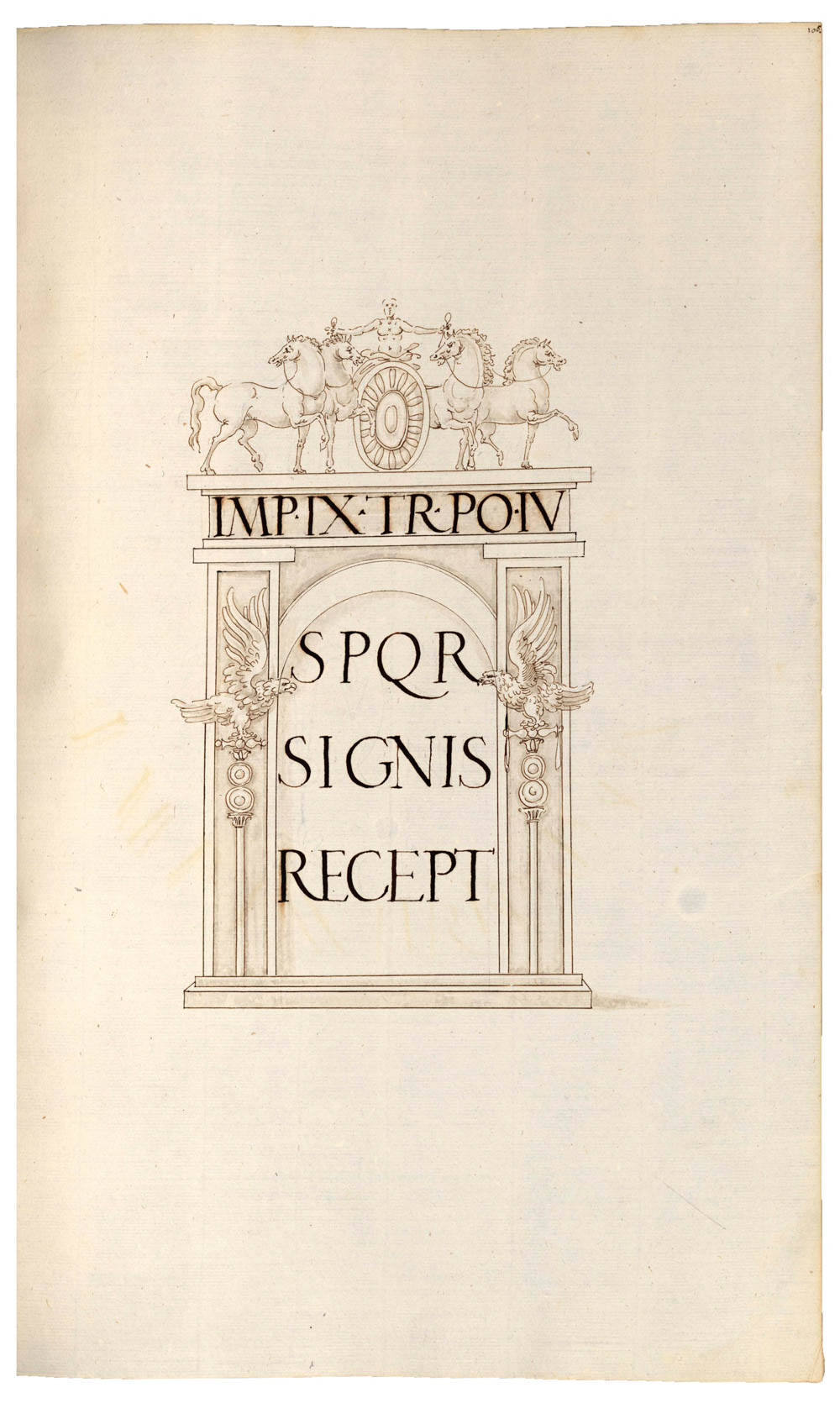
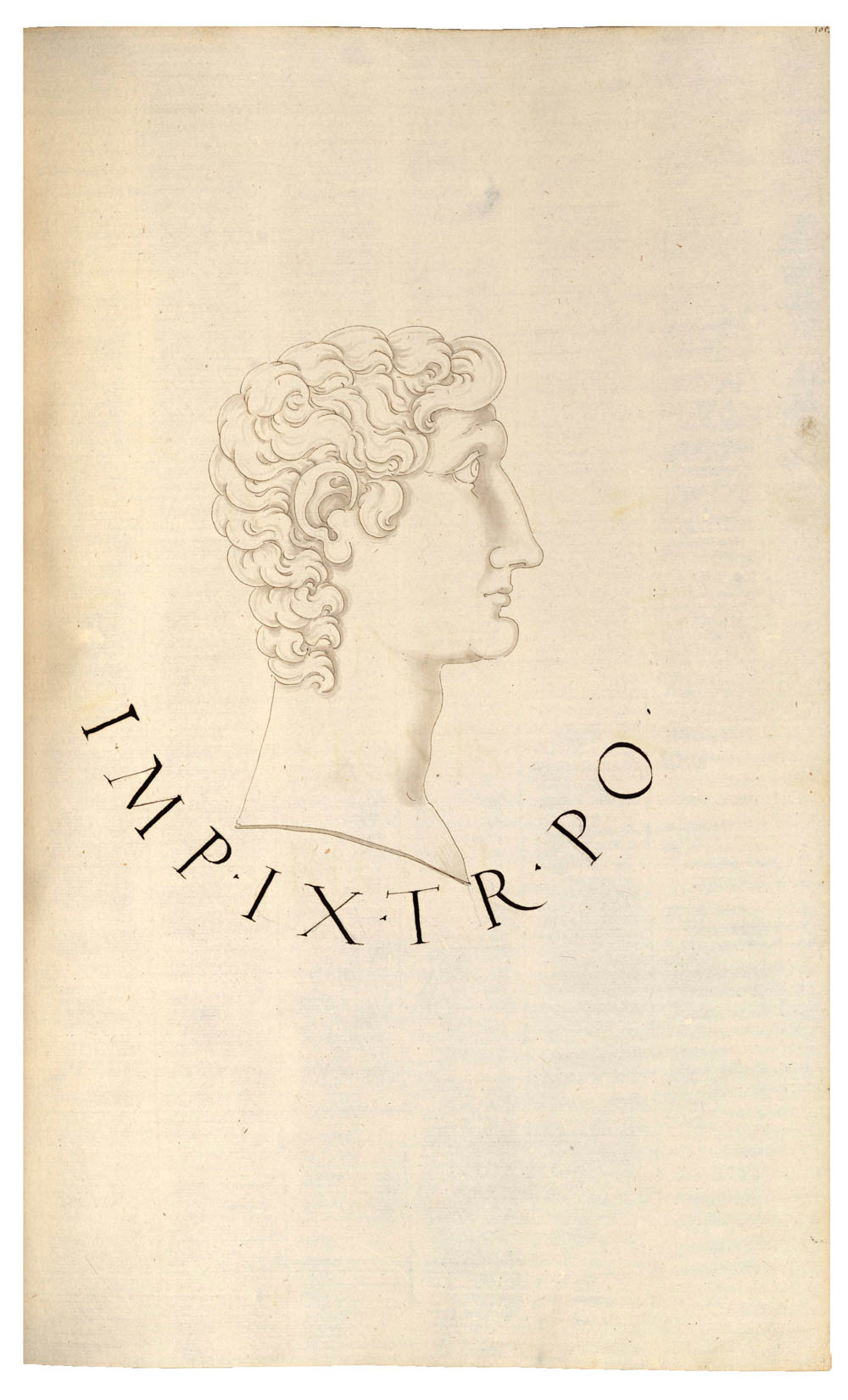
3.4
Of the fourth and last, unidentified coin, the obverse is
visible in the sixth volume of the MaNO on fol. 41r (fig.
19a: Augustus looking right, legend: DIVVS AVGVSTVS)[57],
while the reverse is depicted on fol. 42r (fig.
19b:
Augustus and Livia facing each other, legend: M ACILIVS GLABRIO
PRO)[58].
The coin is described in the second volume of the Diaskeué
on fol. 161r no. 81. It is said to have been in the collection
of Enea Vico. The correct obverse is found in volume four on
fol. 46r (fig. 20: Augustus looking right crowned by
Victoria on a column, legend on drawing: CAESAR DIVI AVGVST F)[59].
No other antiquarian reproduces this coin.
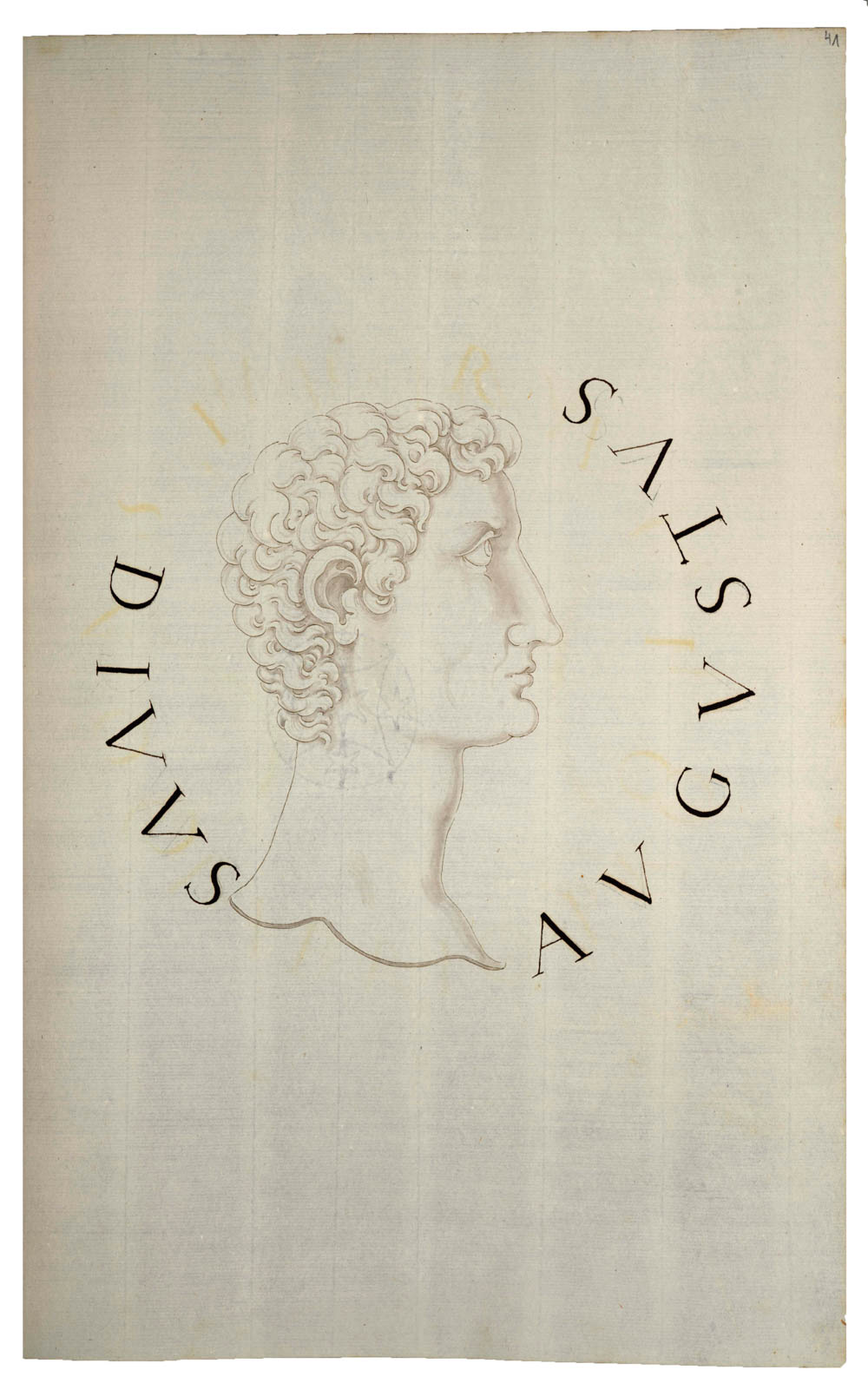
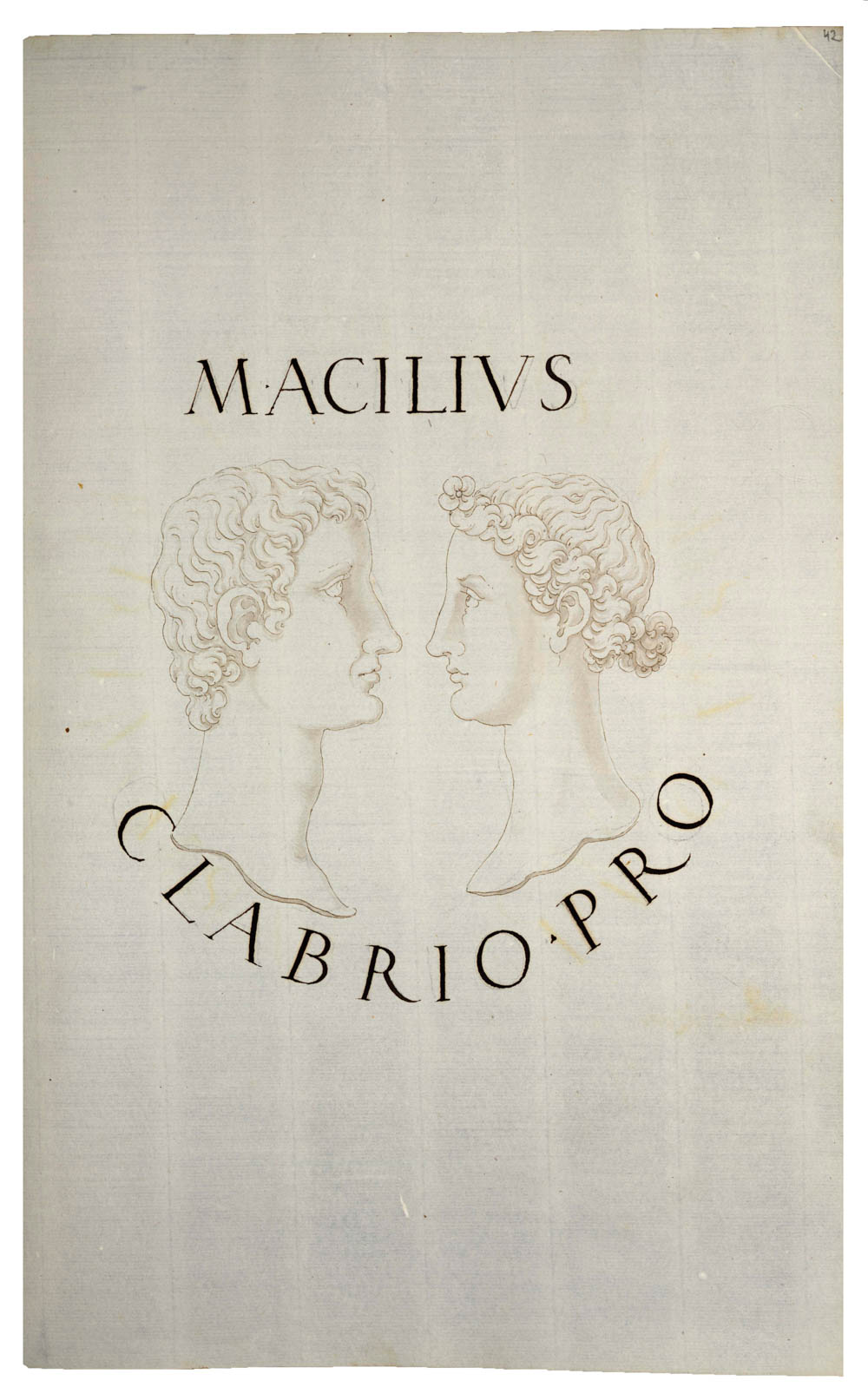
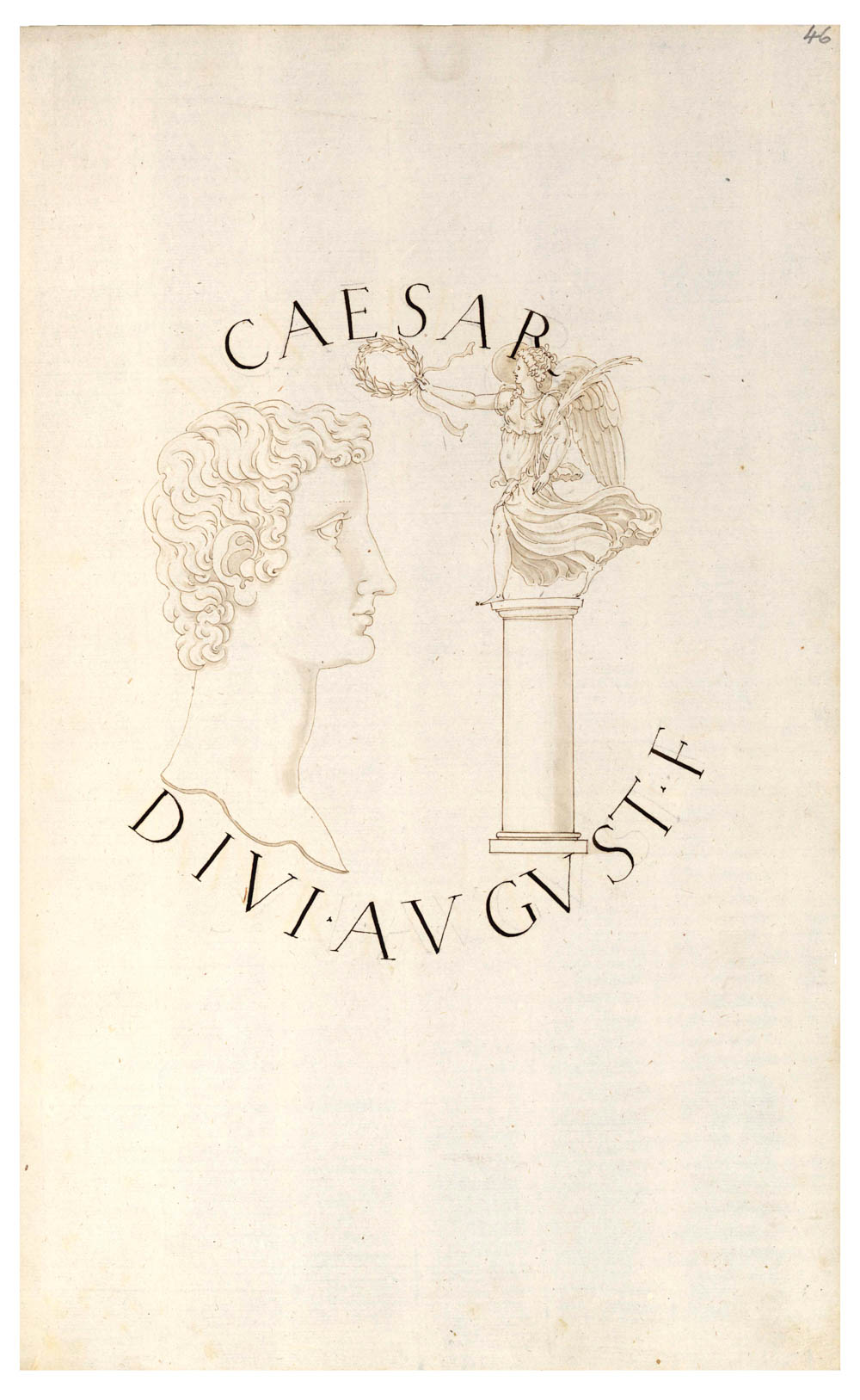
V. The following conclusions can be drawn from
this presentation:
Firstly, most of the
unidentifiable coins can be found in the collection of Jacopo
Strada, i.e. in the case of six coins out of 14. Whether these
coins were really in his collection, as claimed by Strada, can
unfortunately no longer be ascertained, since nothing is known
about the present whereabouts of his collections[60].
The three coins from
Antonio Agustín’s collection as well can no longer be
identified, since his collection was looted by Napoleon’s
troops. The illustrations in his 1587
Dialogos probably reproduce coins from Agustín’s own collection. The
coins described by Strada are however not among them[61].
Therefore, Strada’s information cannot be verified.
The coins from other
collections mentioned by Strada (Medici, Du Choul, Enea Vico,
Achille Maffei) can only be identified with difficulty[62].
Enea Vico adopted nearly
all the coins presented by Strada, i.e. ten out of 14.
Nonetheless, he depicted only the reverses, so that it cannot be
determined with certainty whether he used models from Strada.
Only in cases of inaccuracies in the reproductions in both
Strada and Vico, for example errors in the texts of legends
(here nos. 2.1 and 2.4), can we be sure that Strada
was used as model by Vico. Strada seems to have entertained a
lively exchange with him[63].
Nevertheless, he also regarded him as a great competitor, as he
stated in the preface to his Epitome[64].
Goltzius also was happy
to use Strada’s coin drawings as his source. Therefore, he
depicted three coins in his work as Strada had described them
(here nos. 1.2, 1.3, 2.5). His
presentation of the coins’ illustrations is clearly oriented on
Vico’s model; he was the first numismatist to adopt it[65].
Erizzo, however, only
adopted one coin from Strada (no. 1.2).
Neither Vico nor Goltzius or Erizzo specify
where they saw the depicted coins.
Agustín and Ligorio did
not reproduce any of Strada’s coins with incorrect die
combinations. All of them owned collections, of which Ligorio’s
was considered the most important at the time, according to
Goltzius[66].
Agustin’s was probably one of the largest, containing about
5,500 pieces[67].
Ligorio also visited a
great many coin collections in person. Therefore, in his
manuscripts he provides owner indications that are different
from those given in Strada’s works (e.g. in the case of no.
3.1). Here, Ligorio states a »cavalier Caro« as the owner of a
correctly reproduced coin, while Strada names his own collection
as repository of his invented coin.
Two of Strada’s
inventions were never accepted by other antiquarians (nos. 1.1
and 3.4). The first coin is said to have been in the Medici
collection, the other in the possession of Enea Vico. It is
therefore quite surprising that Vico did not illustrate a coin
from his own collection in his works. This fact could be another
indication that Strada’s information about the ownership of
coins is not necessarily accurate: As a consequence, for his
most imaginative coin inventions, such as the exemplars
depicting the assassination of Cicero, the depiction of the
temple of Janus with a four-headed Janus on the roof and a ship
with elephant prora in his works – in these cases in the
Epitome and Diaskeué – he named diverse owners
(assassination of Cicero) or referred to his own collection as
repository (temple of Janus and elephant prora)[68].
By stating the owner, he provided his inventions with a
›confirmed‹ authenticity. He hardly needed to fear verification
and exposure by his contemporaries, since at the time
communication channels were very slow and unreliable. Moreover,
only a few antiquarians other than himself undertook extended
journeys to visit foreign coin collections, as did Hubertus
Goltzius, for example[69].
Strada justifies his
inventions in the preface of the series with a statement
that »suitable coins have not yet been found
for all inscriptions – they have not yet been discovered –
although they were minted«[70].
Now he had ›found‹ them. His extensive
iconographic knowledge of ancient coins and of their legends
enabled him to do so. As a rule, he used really
existing coin dies and combined them with each other for the
coins presented in his works; as a result, they appeared all the
more credible to his contemporaries. Nonetheless, there were
some, such as Adolph Occo, who expressed doubts about the
authenticity of many coins presented by Strada, even though he
adopted several of Strada’s inventions[71].
Further in-depth investigations on volumes 9 (Nero), 11
(Vespasian) 16 (Antoninus Pius) and 17 (Marcus Aurelius) are
still to be undertaken. In these volumes, several combinations
of non-related obverses and reverses can be found. Many of his
inventions are included in sixteenth- and seventeenth-century
numismatic works and encyclopaedia, even in Occo’s works[72].
A complete and detailed investigation
of the complete set of coin inventions depicted in
the MaNO would be very helpful and important for the
history of numismatics; unfortunately, due to constraints of
time, this further investigation was impossible to achieve as
part of our project[73].
In conclusion, Strada’s
coin inventions as described in the Diaskeué provide
important further evidence that these coin descriptions were not
complementary to the illustrations in the MaNO, as he had
stated in the preface of his Commentary on Caesar[74]
and in the Index sive catalogus librorum, quos composuit aut
componi et scribi curavit aut denique alio modo comparavit[75],
but that these two works constituted two independent pieces of
writing.
Translation: Andrea M.
Gáldy
[1] For a
survey of these works: Heenes 2019, pp. 17–34.
[2] Also
see Heenes 2020, pp. 75–76.
[3]
A.A.A. NVMISMATΩN ANTIQVOR: ΔΙАΣKEYH.
HOC EST,
Chaldaeorum, Arabum, Libycorum, Græcorum, Hetruscorum,
ac Macedoniæ, Asæ, Syriae, Ægypti, Syculorum, Latinorum,
seu Romanorum Regum, a primordio Vrbis, Deûm, Coss.
tempore Reipub: & crescente adhuc, tam sub Cæss.
Latinis, in occidente, quam Græcis Impp. in oriente,
declinante Imperio P.R. denique Hexarchorum, Barbarorum
Principum, Ducumuè: METALLICARVM EICONVM explicatio. Ex
Musæo IACOBI STRADÆ Mantuani Antiquarij, Ciuis Romani:
Cum septem Indicibus Locupletissimis, partim
Alphabeticis, quibus res diuersissimæ continentur,
partim serierum, quæ Regum, Cæss. Impp. ac Tyrannorum,
necnon Heroinarum nomina perscribunt.
[4]
MAGNVM AC NOVVM OPVS
Continens descriptionem Vitae imaginum, numismatum
omnium tam Orientalium quam Occidentalium Imperatorum ac
Tyrannorum, cum collegis coniugibus liberisque suis,
usque ad Carolu(m) V. Imperatorem.
A Iacobo de Strada Mantuano elaboratum.
TOMVS PRIMVS. ANNO DOMINI MDL.
[5]
Dialoghi,
p. 117: »My friend Pirro Ligorio from Naples, a great
antiquarian and painter, has written over forty books
[i.e. manuscripts] about coins, buildings and other
things [...] without really mastering Latin, as did
Hubertus Goltzius, Enea Vico, Jacopo Strada and others.
Those who read their books might think that they have
read all the Latin and Greek books ever written. They
took what they needed from others and they drew exactly
with the pencil what others described«.
See chapter 7 on »Strada’s Numismatic
Method« in the forthcoming publication of our research
results: Jacopo Strada’s Magnum ac Novum Opus: A
Sixteenth-Century Numismatic Corpus (CYRIACUS.
Studien zur Rezeption der Antike 16); in what follows
the title is abbreviated to Heenes – Jansen
(forthcoming).
[6] See
Dekesel 1995, pp. 210–222.
Cunnally 2016, p. 6, even speaks of a »Renaissance
nummomania« current at the time.
In my essay I cite Erizzo’s edition
of 1585–1590 (Varisco – Paganini), in what follows
abbreviated as Discorso 1585–1590, since it is
the most comprehensive. I would like to thank Ginette
Vagenheim for making me aware of the differences between
the individual editions of Erizzo’s works. On the single
Erizzo editions, see: Peter 2013, pp. 159–177.
[7]
Vienna University Library,
Sig. III-160.898/2.
[8] After
the figure numbers, Strada’s interpretation and the coin
legends in the Diaskeué are briefly mentioned.
[9]
MaNO 4,
fol. 196r (CensusID
10174940); fol. 197r (CensusID
10174944).
[10]
MaNO, 4
fol. 188r (CensusID
10175427); fol. 189r (CensusID
10175431).
[11]
Caesar Augustus,
Taf. XLVII Nr. XV (CensusID
10155427, no individual
identifications), there linked to pl. X no. 109,
correct, Augustus is however turned to the right.
[12]Erizzo,
Discorso 1585–1590,
p. 41.
This illustration is not found in the first edition of
the work but only in the edition published by Varisco –
Paganini in the years 1585‒1590, which appeared after
Erizzo’s death. It is therefore very likely that it was
added by Varisco – Paganini without the author’s
knowledge. It is possible that their source had been
Strada.
[13]
Discorsi,
p. 55 (CensusID 10068763). It can be
found in the edition of 1555.
[14]
MaNO 4,
fol. 258r; MaNO 4,
fol. 259r (CensusID
10175892).
[15] Cf.
chapter 5 »Strada’s Numismatic Works« in Heenes – Jansen
(forthcoming).
[16]
Caesar Augustus,
pl. LVII no. III (CensusID
10155538, no individual
identifications) is paired with the correct obverse:
Taf. VIII Nr. 88 (CensusID
10153859, no individual
identification).
[17]
MaNO 5,
fol. 204r (CensusID
10174588); fol. 203r (CensusID
10176387).
[18]
Omnium Caesarum,
pl. BBVII no. 78 (CensusID
10024666).
[20]
MaNO 4, fol.
213r (CensusID
10174114).
[22]
Caesar Augustus,
pl. XXXVI no. XIIII (CensusID
10158136).
[23]
Caesar Augustus,
pl. IX no. 114 (CensusID
10158132).
[24]
AST 21, p. 100, fol. 73r nos. 740 & 741.
[25]
MaNO 4 fol.
128r (CensusID
10173645); MaNO 5 fol.
77r (CensusID
10174982).
[26]
Omnium Caesarum,
pl. BBI no. 9, Le imagini,
pl. 14r I (CensusID
10028315).
[27]
Caesar Augustus,
pl. LXXIII no. XXI
(reverse
CensusID 10157765),
correctly linked to pl. XIII no. 153 (obverse
CensusID 10157761);
in Agostin’s Dialoghi, p. 153, it is
paired with another, potentially correct obverse (CensusID
10031255).
[28]
MaNO 2, fol.
82r (CensusID
10171672).
[29]
Omnium Caesarum,
pl. BBVI no. 67
CensusID 10024694;
Le imagini, fol. 16v G (CensusID
10029707).
[30]
Caesar Augustus, pl. IX no.
101, pl. LXXII no. XI (CensusID’s
10157598 +
10157602);
AST 21, p. 100 fol. 73r nos. 742 & 743.
[31]
MaNO 4, fol.
21r (CensusID
10174767).
[32]
Le imagini,
fol 17 A (CensusID
10029756); Omnium Caesarum,
pl. BBVII no. 73 (CensusID
10024655).
[33]
MaNO 4, fol.
57 (CensusID
10174779).
[34]
Le imagini,
fol. 16v H (CensusID
10029710); Omnium Caesarum,
pl. BBVI no. 68 (CensusID
10024696).
[35]
Caesar Augustus,
pl. XXXI no. XXX (CensusID
10153994, no individual
identification). The obverse pl. II no. 22 is not
correct (CensusID
10153824, also without
individual identification). The correct reverse is
depicted on pl. IX no. 104 (CensusID
10158132).
[36]
MaNO 5, fol.
115r (CensusID
10176610).
[37]
Le imagini,
fol. 14v A (CensusID
10028377),
Omnium Caesarum,
pl. BBII no. 13.
[38]
Discorso
1585–1590, p. 24 (CensusID
10013376).
[39]
Caesar Augustus,
pl. LXXIII no. XV (CensusID
10157620) with the correct
obverse pl. IIII no. 39 (CensusID
10157613).
[40] AST 21,
p. 92 fol. 67v nos. 669 & 670.
[41]
MaNO 5, fol.
4r (CensusID
10174368).
[42]
MaNO 4, fol.
174r (CensusID
10174374).
[43]
MaNO 4, fol.
175r (CensusID
10176979).
[44]
Omnium Caesarum,
pl. BBVIII no. 88 (CensusID
10018390).
[45]
Caesar Augustus,
pl. XXXVII no. XXXII (CensusID
10224548) and no. XXXIII (CensusID
10158706).
[46] AST
21, p. 63 fol. 47r no. 410 and 411.
[47]
MaNO 5, fol.
40r (CensusID
10174606).
[48]
MaNO 4, fol
22r (CensusID
10174609).
[49] MaNO
4, fol. 23r (CensusID
10224478).
[51]
Discorso
1585-1590, p. 6; Caesar
Augustus, pl. XLIX no. II and pl. IIII no. 45 (CensusID
10155450; no individual
identification); Dialoghi, p. 191 (CensusID
10018368); AST 21, p. 68 fol.
50r no. 457 and 458.
[52]
MaNO 2, fol.
106r (CensusID
10173659).
[53]
MaNO 2, fol.
105r (CensusID
10173661).
[54]
Le imagini,
fol. 15v H (CensusID
10029437),
Omnium Caesarum,
pl. BBIIII no. 44.
[55]
Caesar Augustus,
pl. XXXIX no. XIIII is not paired with the correct
obverse, i.e. pl. XIII no. 149. The correct obverse can
be found in Caesar Augustus pl.
XIIII no. 160 (CensusID
10153770).
[56] AST 21,
p. 84 fol. 60r nos. 556 & 557.
[58]
MaNO 6, fol.
42r (CensusID
10178086).
[59]
MaNO 4, fol.
46r (CensusID
10224588).
[60] The
projected sale of his collection to Wilhelm von
Rosenberg and Elector August of Saxony did not come off.
After Strada’s death, the collection was »scattered to
the winds«; Lietzmann 1997, pp. 384–385; 387–388; 394.
Dirk Jacob Jansen provided this information on 5 March
2021.
[61]
Agustín bequeathed his coin collection to the Spanish
King. It included 130 gold coins, 1,400
coins in silver and 3,871 in bronze. The
bronze coins were taken to the coin cabinet at the
monastery San Lorenzo de El Escorial. From there, they
were stolen by Napoleon’s troops; their present location
is unknown. In the original edition (Dialogos)
only 292 coins are depicted on 52 plates. These probably
come from Agustín’s collection (information provided by
Paloma Otero, Museo Arqueológico Nacional, Madrid and
Mariano Carbonell, Universitat Autònoma de Barcelona).
[62] My
request for information about the coin from the Medici
collection could not be answered, since during the past
three years no new curator has been appointed for the
department of ancient coins at the Archaeological
Museum, Florence; information provided by Mario Iozzo on
5 March 2021. Nothing is known about the whereabouts of
the collections of Achille Maffei, Francesco Venier and
Enea Vico; information provided by Federica Missere
Fontana on 6 March 2021. On sixteenth-century coin
collectors, cf. Missere Fontana 1994, pp. 343–383: on
Francesco de Medici, see pp. 350–351; Achille Maffei pp.
358–359; Francesco Venier pp. 367–368; Enea Vico pp.
368–370. There also seems to be no information on the
present whereabouts of the collection of Du Chouls.
Unfortunately, my two inquiries addressed to Jean
Guillemain remained without answer.
[63]
Missere Fontana 1994, p. 364.
[64]
Colophon of the Epitome, p. A
4r.
[65] Lemburg-Ruppelt
1988, p. 167.
[66] Peter 2009, p. 123.
[67] See
note. 66.
[68] Also
see Heenes 2020, pp. 59–65 (DOI
10.17879/ozean-2020-2914).
[69] On
Strada’s travels, see my chapter »Strada’s Numismatic
Works« in the publication of our project. Hubertus
Goltzius undertook two long journeys, during the first
of which he visited 799 Münzsammlungen; see Dekesel
1988, p. 7.
[70]
Series,
fol. 1r.
[71] See
the following note.
Introductio, p. 188 cites
Charles Patin Adolf Occo’s statement about the volumes
at Gotha: »... ibidem miraberis sane et nummorum
varietatem et sumptuum gravitatem: sed omnio puto multos
esse appictos qui non sunt in reum natura.
Thesaurus est pretiosus et Principe
dignus«; von Busch 1973, p. 348, note 141.
[72] E.g.
Diaskeué 4, fol. 15r, p. 667, no. 7 for
MaNO
14, fol. 24r (palace of
Nerva) in: Imperatorum,
p. 146; Diaskeué 4,
fol. 33r, p. 703, no. 51 for
MaNO
14, fol. 112r (Imperator
on horseback, in the foreground the river god Nile with
hippopotamus) in:
Diccionario, vol. 5, p. 261;
Diaskeué 4, fol. 46v, p. 730, no. 86 for
MaNO
14, fol. 158r (city walls
of Selinunt) in:
Lexicon universae,
vol. 4, 1, col. 1581;
Diaskeué 4, fol. 72r, p. 781, no. 180 with
MaNO
14, fol. 172r (cityscape
of Babylon) in:
Lexicon universae,
vol. 5, 1, col. 1486. Most
recently Woytek – Williams
2020, p. 296 on two inventions of coin types that are
also to be found in Occo’s edition Imperatorum.
[74]
C. Iulii Caesaris,
Dedicatoria.
[75]
Index,
fol. 1v. This is a list of
books that Strada had yet to publish; for the complete
list, see Jansen 2019, pp. 902–914.